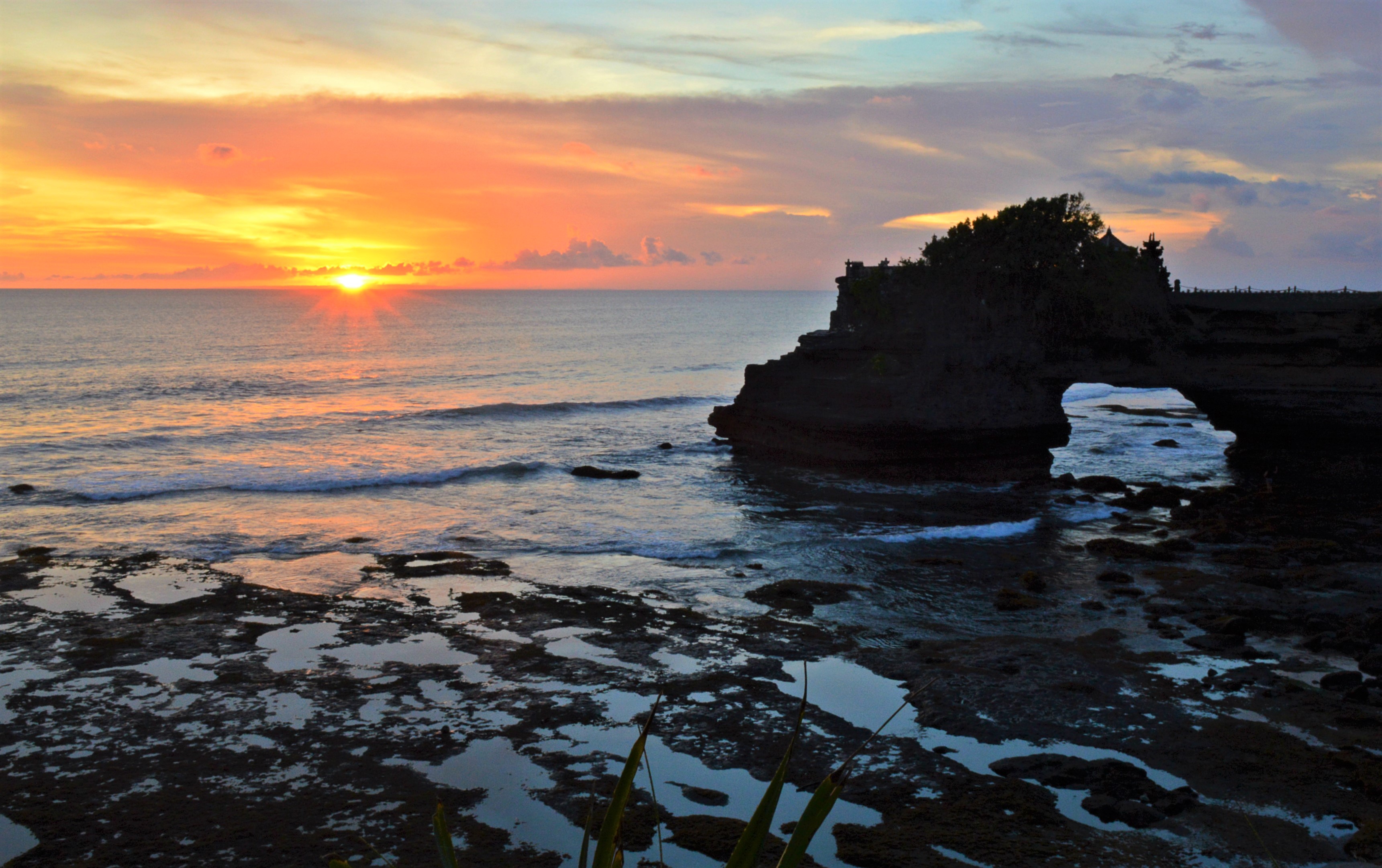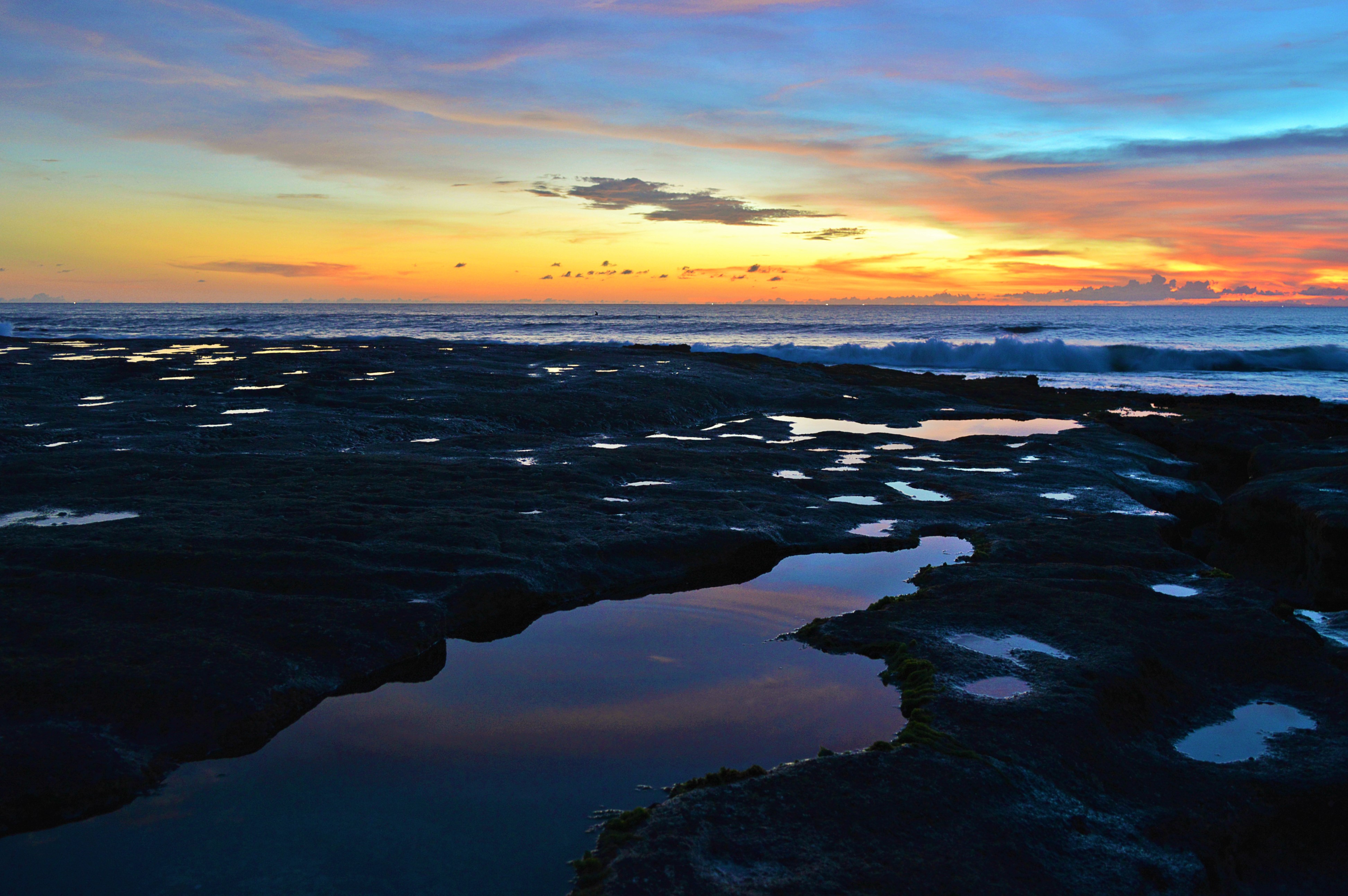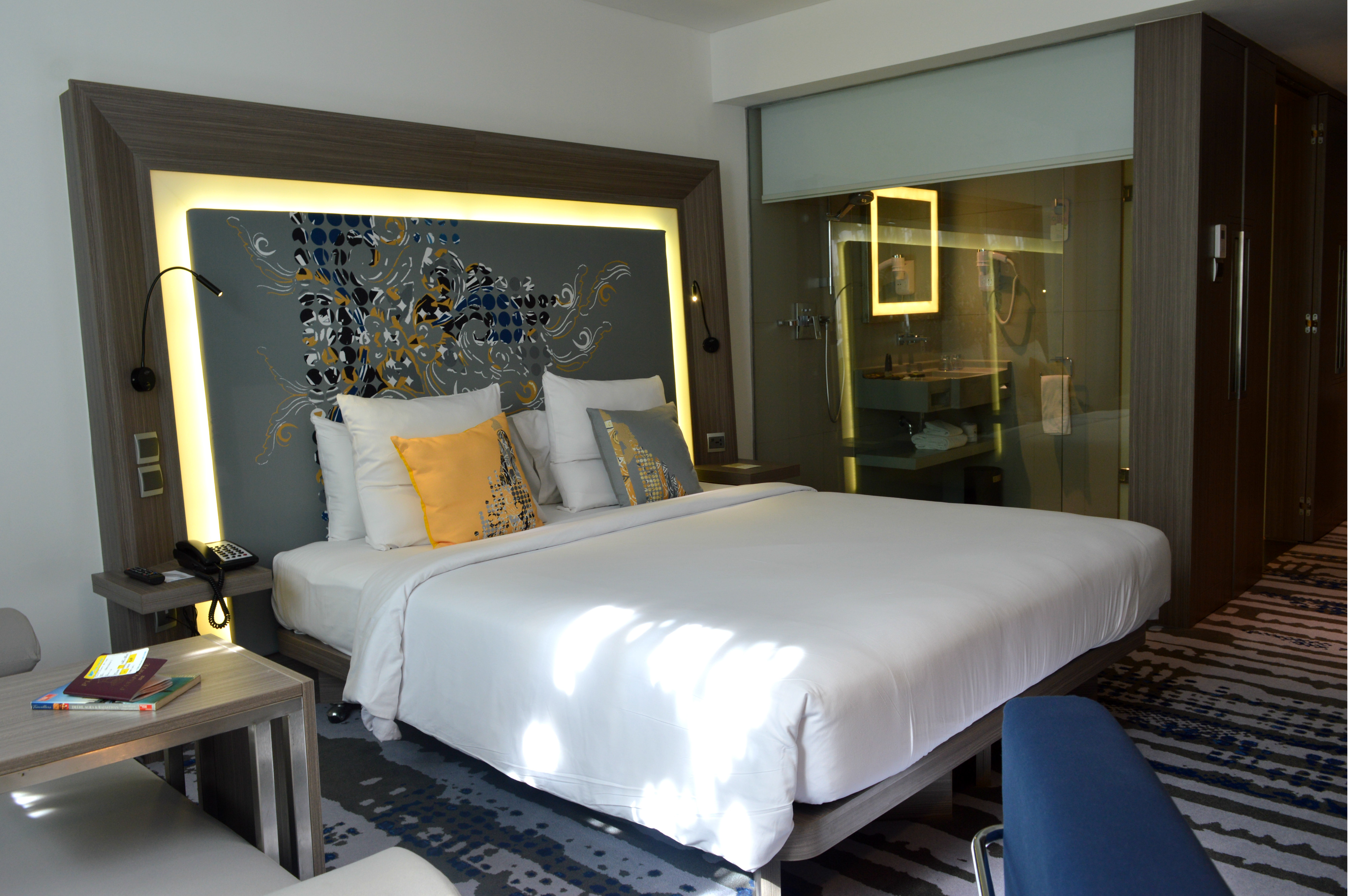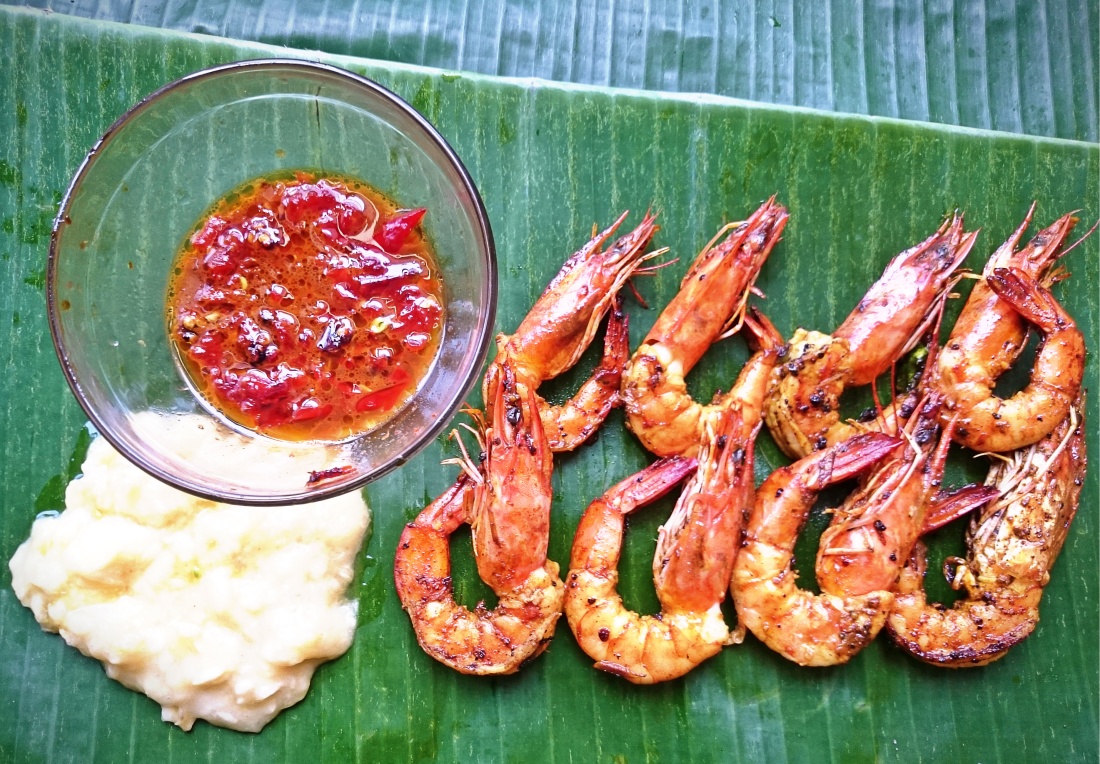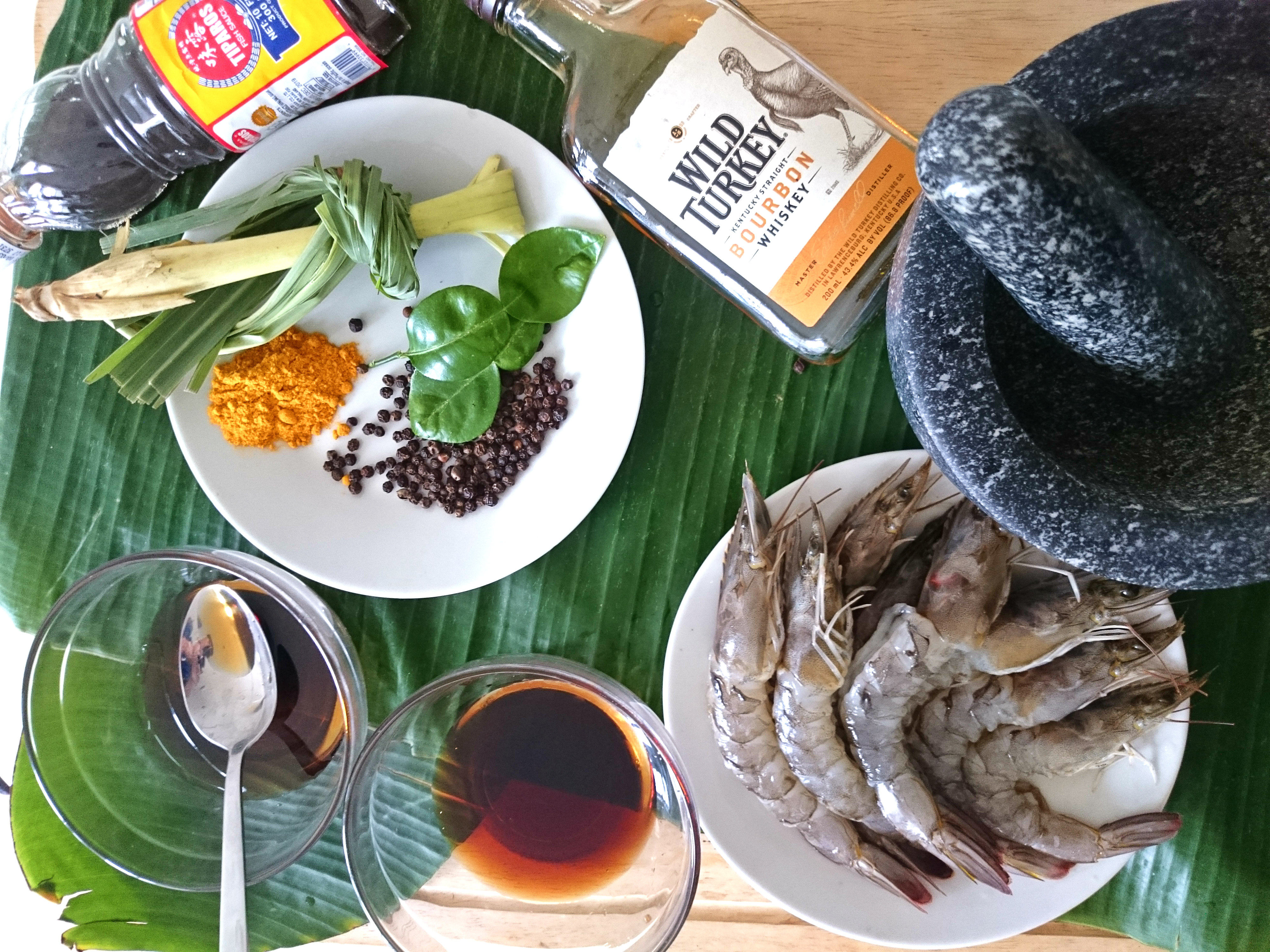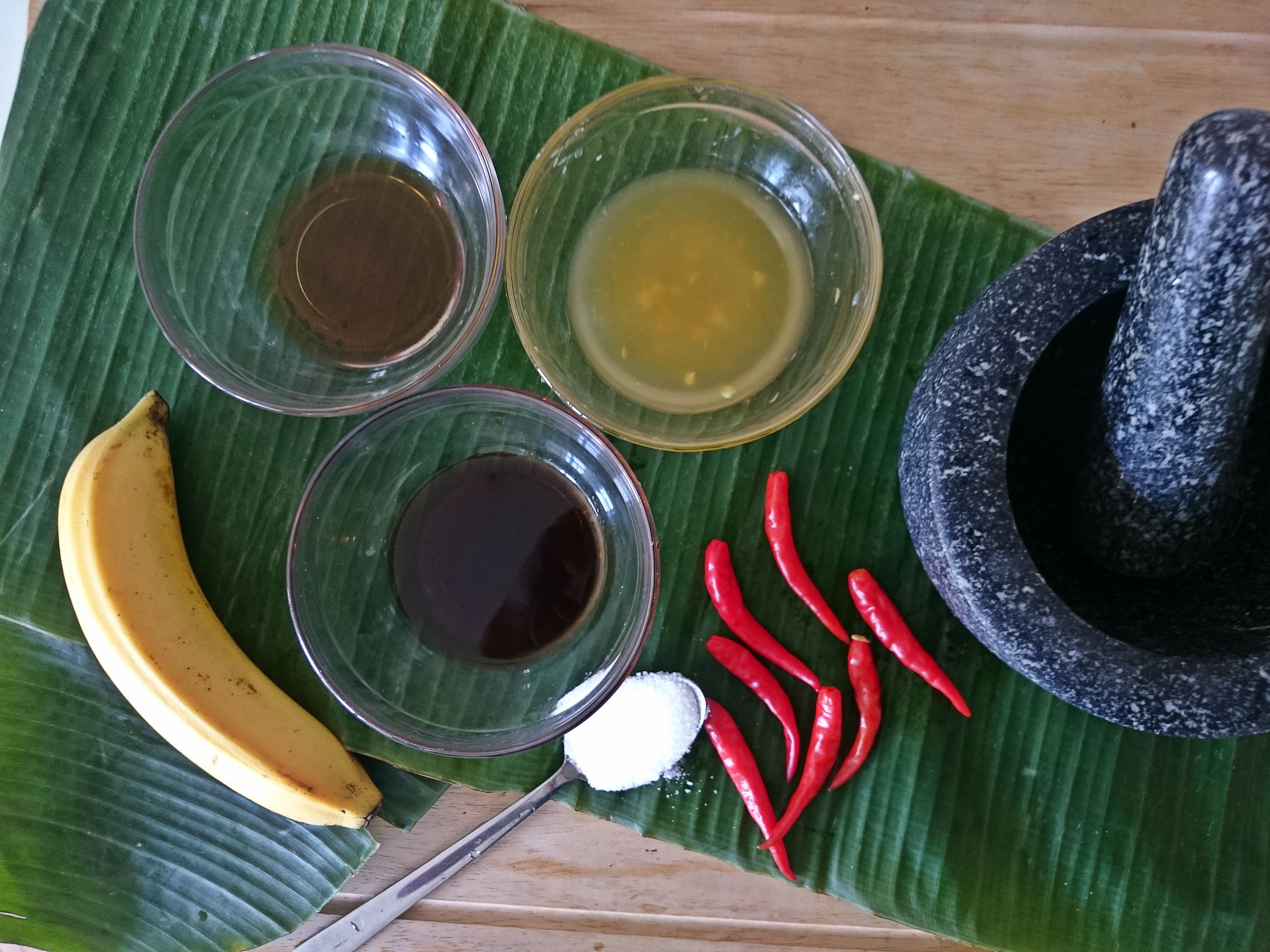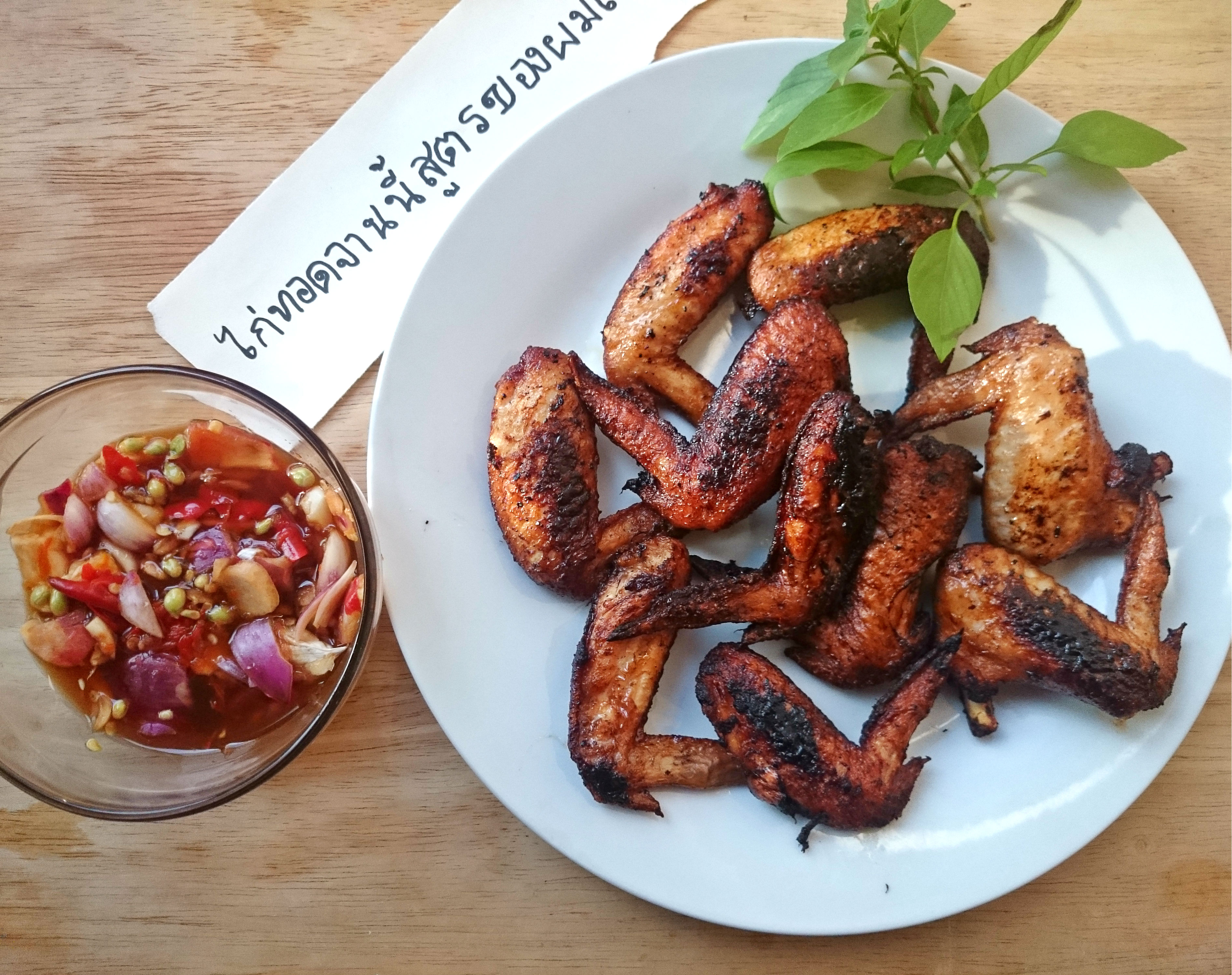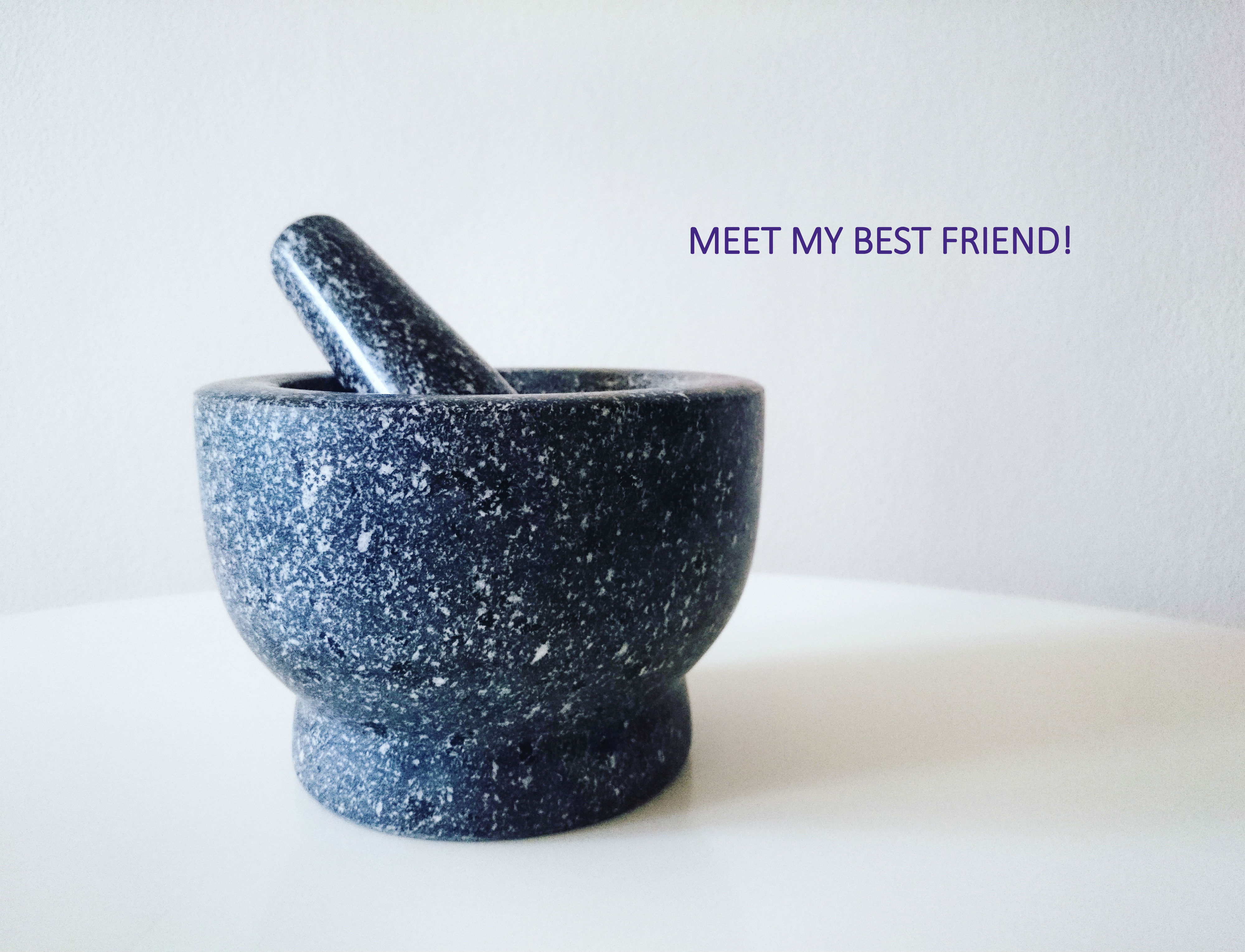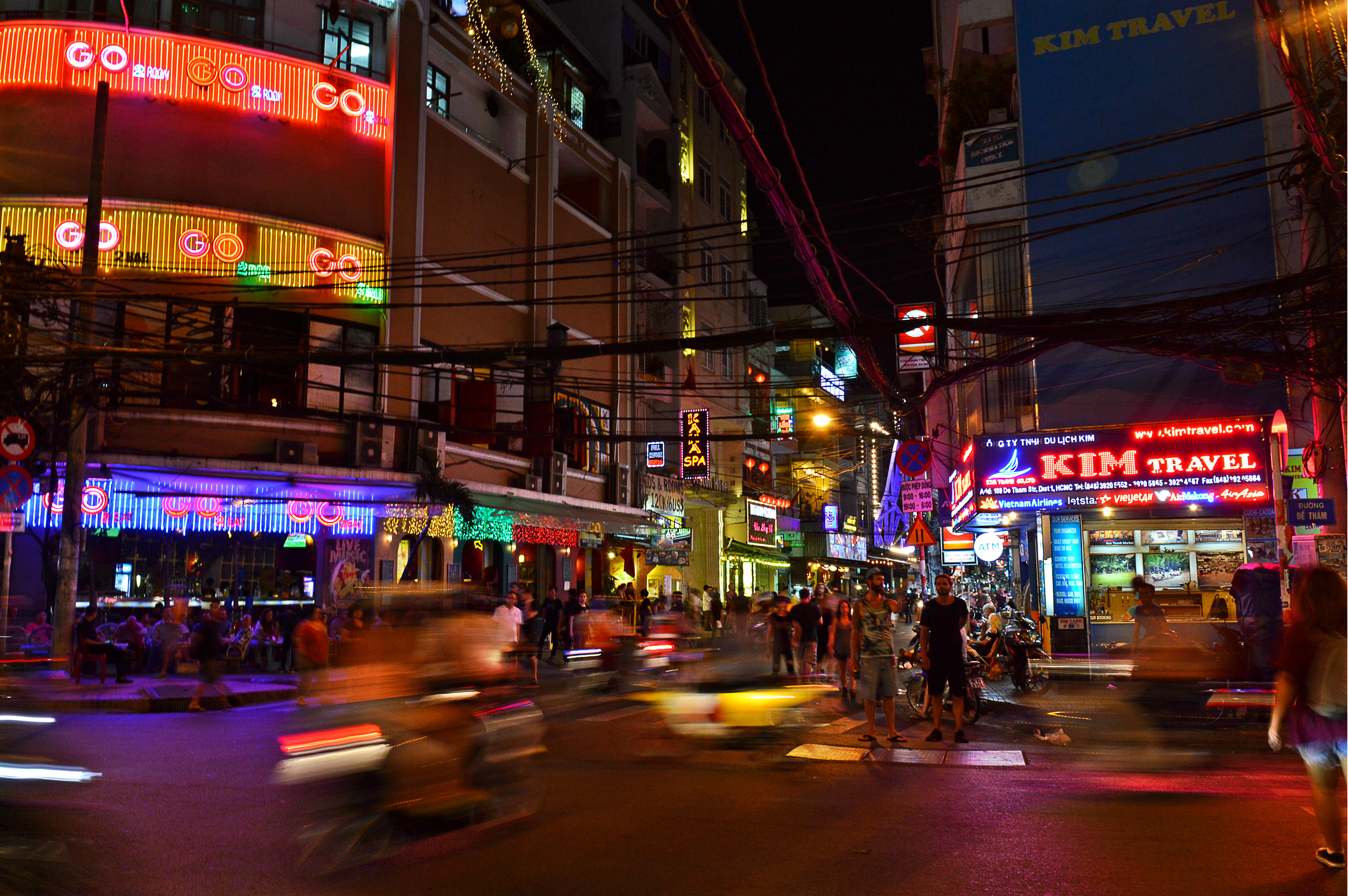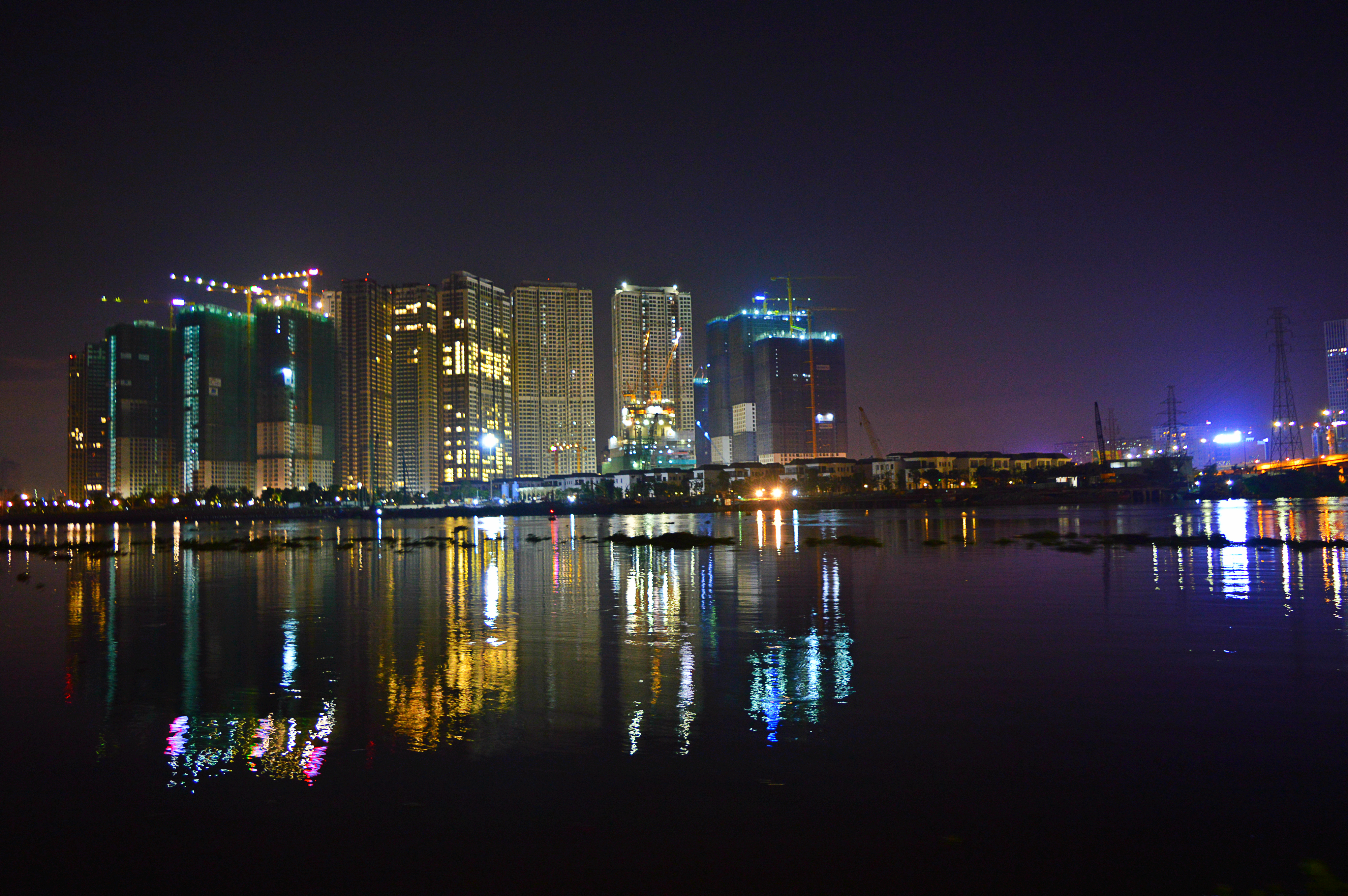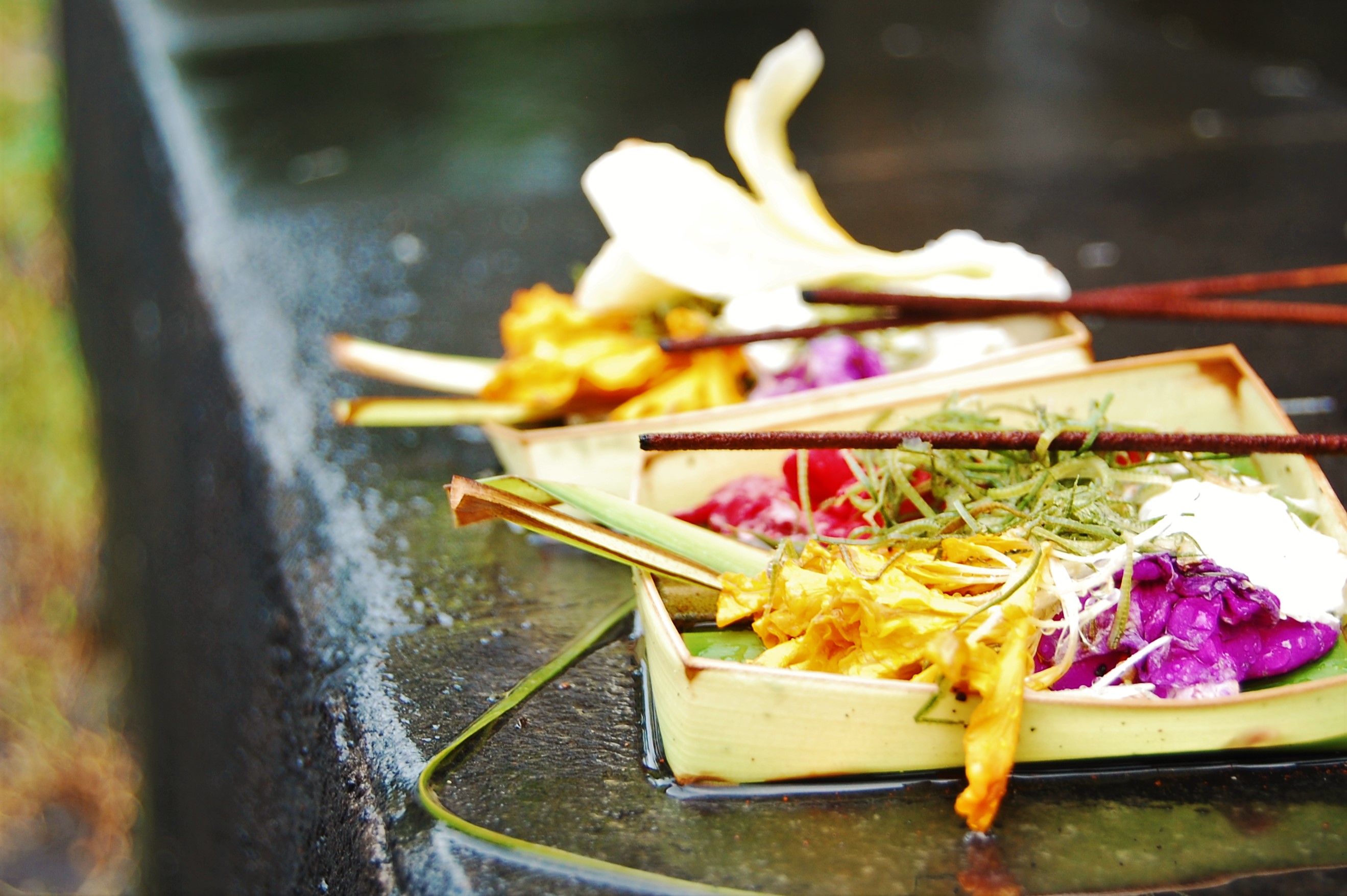
Prologue.
I got my first taste of traveling before I could even learn to write my name. Memories of carefree wading on mellow beaches, along with my stubbornness and refusal to wear sun protection, are some of what I would call clips of a sunny childhood, and which would ultimately shape the way I see the world through traveling. By the time I had started school (and had learned to write my name, of course) I had had already gone to many spectacular places, which would eventually fuel my unending desire for journeys to many different cities and countries. But there was one problem: I had motion sickness.
Yes—I was a little puking boy, and every so often, puking at the wrong places.
Today I am feeling like the little puking boy that I was, only I wasn’t motion sick, but hungry.
This is how I arrive in Bali.
The immigration officer looks at me for two seconds and stamps my passport without asking any question; I interpret this as his way of saying, “Welcome to Indonesia! You stay for 30 days—I tour you around.” It’s disturbing in a good way. I mean—I was expecting to encounter a nosy international border control officer with a list of canned question the same way I encountered several interesting ones in the past. But this one is different. And he seems friendly too.
But look who’s friendlier! The customs official who—after finding out I was Filipino (and a living thing devoid of any contagious diseases)— thanked me in Filipino. The Balinese are indeed a hospitable bunch. And quite surprising too.
As I step out of the arrival hall right past the SIM card booth, I find myself asking this question the border control officer failed to: What am I doing here?
But I have always wanted to be here. Maybe I want to eat something different or maybe get acquainted to the local culture, or maybe—just maybe, meet people who have stories to tell.
And so, I start my story by saying:
Every one in Bali is friendly…
…or, maybe not!
The most unfortunate thing that can happen to a traveler arriving in Ngurah Rai International Airport is to be consecutively greeted by 5 touts and be followed everywhere (or make a sudden appearance out of nowhere) be offered a “convenient” ride to Ubud (an hour ride from Kuta) for IDR 400.000 (USD 30). I declined as it was unwise to do so. Also, I was having trouble focusing on my cigarette.
A cheaper way of getting to Ubud, as well as Bedugul and back to Kuta, is to grab a metered Bluebird Taxi outside the airport and head to Perama’s office on Jalan Legian in Kuta and book a shuttle. Mine was a bargain; it only cost me IDR 130.000.
“Make sure you count your change. Indonesian currency has a lot of 0’s in it” warns Pita, the Perama lady with a thousand-watt smile..
I pause for a moment and say to myself: No wonder my 4 million rupiah can’t fit in my wallet!
“Terimah kasih,” I say in an attempt to speak a little Indonesian.
“Suksma—that’s “Thank You” in Balinese.” she teaches me, then adds, “Next time you book with us, bring the old receipt to get a discount.”
Now, Balinese is a complicated affair I dare not involve myself in. This language is as complex as the culture—both in equal measure—it’s best left to the experts: the Balinese. A few handful phrases can go a long way, but English is widely spoken here (and Indonesian too) you are assured of a good time sans the language barrier. I mean, it’s not like you are in mainland China where—to be able to know where the Band-Aid section is— you would either speak Chinese (and you better get the intonation right) or rely on creative hand gestures.
To some there is a kind of familiar comfort in this place which, interestingly, many Australians claim to be their “hometown” as is the case of Kuta. But unless you head to the more cultural areas in Central and North Bali—where in the terraced rice paddies, foggy and enchanted lakes and mystical mountains await the true spirit of the island and its people—having too much of Kuta will feel like that irresistible cocktail you’ve had too many the night before, you will end up feeling hung over and empty.
But Bali is not all cocktails and cheers, you know. Sure, the island is known to be a tropical paradise and a yoga heaven, but it did have its fair share of bloody wars in the past such as during the Dutch intervention where a thousand Balinese marched to their death to defend their island against the Dutch invaders; it is hard to imagine what life was like back then. (I am sure no one was sipping cocktails on a terrace overlooking the ocean). And let’s not forget the pre-colonial slave trade far worse than their contemporaries. But things did change when the government decided to campaign for the island in the 1960’s. Soon, the flower children and surfers came and discovered Kuta—then a sleepy village—and word spread out like a massive Tsunami, Bali became so hot and hip—everyone wanted to be here.
I tell you now, not even the 2002 Bali bombing can stop people from flocking here in massive droves. Visitors are good for tourism. Tourism is good for Bali. Bali is back to being happy. Happy is how we should feel. I feel hungrier now.
Part 1:
Ubud, Central Bali.
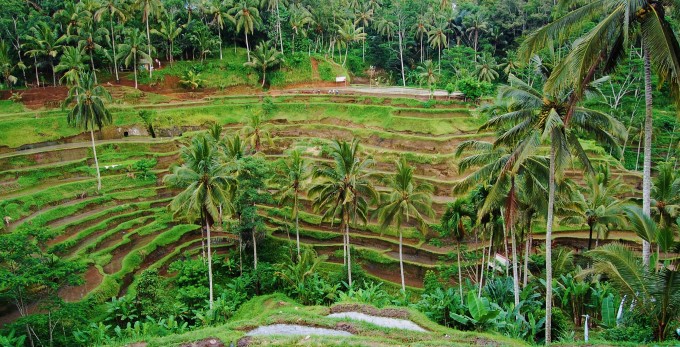

Pura Melanting
1
“You want to buy sarong. I give you morning price.”
This is how I am greeted by a gentle-looking old lady siting outside her tiny batik shop. I calmly look at her, observing every wrinkle as if it were a river full of emotions, and finally notice her eyes translucent as unpolished stone. I nod as a sign of approval yet forget to excuse myself for having a face inundated by sweat. How impolite of me!
Made starts to look for the best sarong among what seemed like a jungle of batik. Unraveling as if they were tangled wires, she manages to find one that is intricately designed, hauntingly indigenous, yet very masculine.
“You like this one? I show you how to wear,” she suggests as if to convince me.
I stand in silence and extend my arms sideward. And it no longer matters if I am on the sidewalk between Jalan Hanoman and Jalan Sugriwa—Made is determined to wrap the sarong around my waist, and all I can do is observe and be quiet. I feel like a child being dressed by a mother for a very important ceremony.
Now I look like her. We sit down and chat for a while.
I have just made a friend in Ubud and—without even noticing it—got initiated into the Balinese culture.
“You from Japan?” she asks me.
“No, Made. I’m from the Philippines,”
This question is not new to me. I can’t remember the countless times I got asked where I am from. Whether this is an advantage or a disadvantage, I don’t know. All I can think of is that I look confusing to many. I remember being asked if I was Indonesian in Kuala Lumpur once. In Manila I got approached by Koreans asking if I was Korean. I was also asked by others if I was Vietnamese, or Thai. I even got asked if I was either Mexican or Peruvian! I would have loved it if they guessed my nationality right. But alas! My features are strange to the majority.
Made offers me a handful of Lanzones (Ceruring in Balinese) and Rambutan so I have something to eat as I walk to my hotel. A kind woman, this Made. She even offers I eat durian, asking if I know the fruit. I chuckle and don’t say a word. I mean, how would Made react if I told her I grew up eating a truck of durian (I love my childhood!) and how over the years I finally mastered the art of eradicating its stench by rubbing my hands onto the fruit’s smooth chamber. I would end up leave her in shock had I lectured her on the art of getting rid of that funky smell. As a courtesy, I managed to shut my mouth.
I bid farewell and start walking to my hotel, of course carrying the bag of Lanzones and Rambutan Made specifically prepared for me.
Well, the hotel is actually just a few blocks away, but feels like a long torturous walk given the sweltering heat. I see a lot of distractions along the way and instantly lose focus. The Balinese are famous for their exquisitely designed family compounds, and I am in awe looking at these artsy structures. I take some photographs of the area only to disturbed a few minutes later by a vehicle honking furiously—it is fast approaching me. I then realize am on the wrong side of the road!
That was close—I thought.
By the way, today I am staying at Teba House on Jalan Sugriwa which is about a mile from the town center. The staff approach me like they know me personally, which is great. They lead me to my room, hand me the keys and I start unpacking. I check the time and realize Ibu Oka is closing very soon. I haven’t even had a decent meal yet since I arrived. So I leave the hotel in high hopes that I get to make it to the warung on time.
And yes, Warung Ibu Oka is not hard to find. There are two branches in town: The first one is just across Ubud palace—always full of tourists and sells out easily, while the other requires effort to get to. After what seemed like a maze and following a sign of a pig with an arrow coming out of its mouth, I manage to arrive at Ibu Oka 3. Now I am not really an Anthony Bourdain fan, but they say this dude is responsible for the popularity of Ibu Oka’s famous Babi Guling—a spicy roast suckling pig with secret (and magic) ingredients—it has become an institution. And it has a huge following.
Babi Guling can actually be found all over the island—to be honest—but Bourdain claims Ibu Oka to be the best. The Babi Guling does not disappoint, I tell you, but I can feel that somewhere out there is a far more superior Babi Guling and I have to discover it myself. Maybe one day. But I am not complaining now; so far I like it.
2
Earlier today I met Ketut Arnata or as I call him Ketut Mr. Cool Cuy On A Cute Motorbike because he seemed like a cool sibling to hang out with. (And his motorbike looks really nice) He was introduced to me by Teba’s staff after I found out that they had no bicycle to lend me (I was meaning to cycle all the way to Tegallalang rice terraces, about 4 miles from the town center. But with all the rain and no bicycle, it’s going to be difficult)
By the time he arrived, the rain stopped all of sudden. What perfect timing! And I couldn’t be more ecstatic. So I sat on the back of his bike with my helmet on and he started his engine and started driving.
“Next time you are in Bali, come to my house. Me and my family cook for you.”
That’s how my conversation with Ketut started. He managed to make conversation in spite of driving like a madman. But the scenery is just too difficult to not pay attention to. I mean, the houses, which looked like temples, and the temples, which looked like houses—all lined up artistically but without any signs of snooty architectural perfection, it makes them appear in their most organic. The rice paddies reminded me of happy childhood summer vacations (falling off a horse is one of them), the sound of coconut trees, in their calm swaying were like familiar songs, and the lovely men and women wearing their traditional sarong, holding their canang sari (daily offerings made out of flowers, rice, incense), and their unique approach to life, religion and balance truly validated the fact that I was and am in Bali.
This place is intoxicating.
Ketut parked his bike together with the other bikes parked along the road. There weren’t too many people at Tegallalang today, and so it was easy for us to find a spot to sit on where the view of the rice terraces was breathtaking. We spent most of the afternoon getting acquainted with each other over a bottle of soda.
“Have you tried Kopi Luwak?” Ketut inquired.
“No. Where can I find that?”
“I take you to this place. Not so far here. You will like the Kopi Luwak.”
So once again I sat on the back of Ketut’s bike as we traveled to a farm that sells Kopi Luwak (Coffee made from Civet droppings). It didn’t take long before we arrived, and the scenery was just as enchanting as earlier.
I met Kadek who was kind enough to tour me around and introduced me to the nocturnal Civet. A cute animal, I thought. And it was wide awake and acting like a grumpy person who hasn’t had brewed coffee yet. (It’s supposed to be nocturnal, this civet) Kadek then showed me how the coffee beans are cleaned several times before finally getting roasted. (I happened to have met the roasting lady who, quite amusingly, looks like this classic Filipino actress) I felt a sense of relief as he explained the process. I mean, come on—animal eats coffee beans, then animal’s digestive system ferments coffee beans and eventually ejects them like waste matter—cleaning several times is a huge deal.
“Would you like to try Kopi Luwak? It will cost you 50.000 Rupiah” Kadek proposed.
That has got to be the most expensive cup of coffee, but I had to try it. Also, the idea that these beans came out of the civet’s body makes it even more exotic and exciting!
“OK. I will have a cup.” I say with an pint of courage.
As I waited for my Kopi Luwak, Kadek brought me 14 cups of flavored teas. I was under the impression he was shitting around. But he wasn’t. In fact, he was bloody serious about having me consume all 14 cups, I began to wonder whether this was his way of “compensating” for the 50.000-worth tiny cup.
“Kadek, I didn’t order this.” I said, confused.
“It’s for you. Free tasting.” He chuckled like my reaction wasn’t new to him.
How hospitable, this Kadek. And so I did have my free tasting as a way to entertain myself: One sip for each cup of flavored tea. And as soon as I finished tasting the last cup of tea, my coffee finally arrived, served in a tiny cup as expected. And it tasted really good! I even had another cup of regular brewed coffee as a basis of comparison.
“Kade, what does Hati Hati mean? I see it everywhere. I’m curious.” I asked.
“It means take care.”
“It’s interesting that in the Philippines it means to share, while take care is ingat.”
“You’re from the Philippines?” Kade came closer to me, obviously amazed, and said, “Let’s talk.”
And that’s how Kadek and I spent about an hour talking about where I come from and why I came here. By the time I finished my coffee, it was already late afternoon (Ketut must have been waiting for so long!) and it was now time (and I did have a hard time saying goodbye) to go back to Ubud.
I stepped out of the farm, I looked at Kadek and his friends and waved at them one last time.
“Hati hati!” I proudly said take care in Indonesian.
“Ingat!” Kadek responded in Filipino.
Then unexpectedly, we all went bursting into laughter and felt really good. I haven’t had a good laugh since I don’t know—I couldn’t even focus on wearing my helmet anymore, I had to have Ketut do it for me.
3
I have this knack for fearlessly talking to strangers and soon turning them into acquaintances.
I am now at Bia Bia+ on Jalan Hanoman having a late night Soto Ayam and Bintang and talking to my waiter who I imagine is asking himself: Why is this foreigner all alone and what is he doing here?
His name is Kamal, a young man in his early 20s. I notice his being fond of asking questions in an effort to practice his English, and I take delight in answering them. He asks where I am from, where I am going and if I can teach him some English, to which I oblige. Brave man—I say. I think perhaps I could make a living in Bali being an English teacher. I mean, the idea is not far-fetched at all. I have read the expat community in Ubud is growing by the day; it is not hard to imagine myself educating people to help them be more confident in the language spoken by many of the foreign tourists visiting Bali.
Kamal, occasionally getting distracted at the sight of the obscene amount of sambal I have on my plate, serves me another Bintang and tells his story:
He comes from a small village in the outskirts of Ubud and has been studying English for about three years now. He dreams of traveling around the world and succeeding one day that’s why he wants to master English in hopes that it would improve living conditions and offer more opportunities. Kamal pauses, mid-sentence, and gives me a sigh; I ask why. He says the money is not enough for him to be able to fulfill his dream. I tell him in a reassuring manner that there’s much to happen to him as he is still very young.
“Do not forget me.” Kamal pleads.
“I won’t.” I say sincerely.
So now I am back at the hotel. I think it is now past 11pm. And I have a load of Bintang with me to enjoy quietly on the terrace. I am accompanied by an army of crickets singing in the background with the leaves swaying gently, it is almost choreographed. And It is so dead quiet now, it is almost surreal.
This is the quietest birthday celebration I have ever had…and I am in a foreign land!
In a few minutes I will be turning 32 and I have no one to celebrate it with. In spite of what seemed to be a lonely situation, I feel genuinely happy and grateful to be experiencing this. Being out of my comfort zone allows me to discover, layer by layer, my very own not-so great self. I realize that in my travels, every person I meet is like a mirror showing me that, while I am literally one person, there are many aspects of me that are yet to be discovered and it needs a certain kind of experience or a change of scenery, for me to truly make sense of things. Not all encounters with different people are pleasant ones though. Some, whether intentionally or not, show me horrors and I usually end up nerve wracked, and it eventually liberates me, one way or the other. In retrospect, the choices I made back then brought me to where I am now. Everything that happens is a result of the choices we make. And so, here I am: Alone, but not lonely.
4
It’s a brand new day and I am done eating my banana pancake. Hurrah! What an energizing breakfast. The sun is out and I can’t help but be excited. In a few hours I will be leaving Ubud and head north, and I only have limited time.
I walk along Ubud’s narrow roads with much delight and excitement my heart is pounding faster than expected, I can even feel my pupils dilating the whole time. My senses now are intensified, it is almost dream-like: I see men, women and children clad in traditional wear as they walk to the temples and their faces radiate happiness. The religious sculptures found almost everywhere offers a great backdrop, the whole town looks like one massive temple. I hear someone playing percussive instruments, probably a gamelan; I imagine there is a ceremony happening. Even the scent of incense adds to the mood that it is far more invigorating than the cup of coffee I had earlier. The chaos caused by the maze of motorbikes of both locals and expats does not seem to bother me any longer. And I make sure this time I am on the right side of the road. At this moment, everything I see, hear and smell is far beyond ordinary and then I remember something: Today it is my birthday.
How could I have forgotten? Just last night I was alone celebrating it with crickets. Today I am in search of a mask, a Barong mask.
So I walk to the market to find it. I check one mask after the other—some were gorgeous while others looked downright ridiculous. Also, they are expensive! Can I afford this? I ask myself. There must be one for me out there somewhere. I decide to come back later and walk a few blocks to enter the famous Puri Taman Saraswati, the lotus temple.
Now this temple honoring Saraswati, goddess of the knowledge and arts, is not what I imagined it to be, at least on the surface. Earlier I visualized myself entering a centuries-old temple that would make me forget about the modern world, at least temporarily. But alas! Much to my shock I see a Starbucks beside it and it is huge! Now that is a reminder of the modern consumerist world. (And I happen to collect mugs and tumblers) Because my perseverance comes from the fact that I always yearn to experience the old, the ancient and the unusual, I enter the temple trying to forget the fact, at least for the time being, that Starbucks is right around the corner, literally.
I see myself standing in one area hoping to spend a moment or two of absolute silence and ultimately mimic the stillness of the pink lotuses that add charm to this already charming place. I find it quite confrontational however that even in this sacred space I am instantly reminded of the mental garbage I have accumulated over the years and it has become so vast I find it difficult deal with it. How could this happen? And why now? Yes, many of us want peace and quiet, and some of us even invest money and time to go somewhere far to clear our minds. But all this mental clutter reveals itself as if I am obligated to embrace it. My mind is so full of obstacles it has become a chore to get rid of them, let alone acknowledge them.
There is a wonderful tale in Hindu Mythology about a chubby yet wise elephant-headed figure known as Ganesh and his brother, the war god Kartikeya. One day Narada, a mischievous sage, arrived and stood in the presence of Shiva and Parvati, parents of Ganesh and Kartikeya, and offered a mango on the condition that only one eats it for it not to lose value. Shiva decided to offer it to Parvati as he could not stand the idea of him eating it alone (I am guessing Parvati might have gone ballistic or what). Parvati felt the same and both decided to decline Narada’s offer. Narada, a clever man, pretended to be heartbroken. Kartikeya noticed the gravity of the situation and asked if he could eat the mango instrad. Ganesh, standing quietly in one corner, was furious as he claimed to have seen the mango first. Ganesh and Kartikeya ended up yelling at the each other only to be stopped by their mother after she proposed a competition. The competition required them to go around the world three times and whoever finishes first will get the mango. Kartikeya was certain Ganesh would never win, so he flew with his peacock and went circling the globe. Upon returning he saw Ganesh already holding the mango. He was in deep shock he demanded for an explanation.
Ganesh explained that his parents were his whole world and circling them three times was enough.
There are many who travel far to gain something such as experience, knowledge, a new craft, new friends, a new cultural understanding or simply peace of mind, and I happen to be one of them—a Kartikeya. It now makes me wonder: When I will become a Ganesh?
Ganesh is often said to be a favorite and is usually the first deity to be venerated when one enters a Hindu temple. Yesterday I had a close encounter with Ganesh at the hotel. His statue was the first thing that caught my attention when I arrived. I imagined him greeting me while I stood there, staring at him to ask him how he was, and if he (only if) can remove the mental clutter that has been plaguing me for many years now.
Ganesh did not say a word.
I can’t remember how long I have been staying in this quiet corner while staring at the lotuses. I didn’t even notice someone is on the other side of the temple. How did she manage to pass by without my noticing? Have I unexpectedly meditated? I look at her curious as to what brings her here. Perhaps she too is longing for peace and quiet. And like me, she wishes to clear her mind from all the mental clutter and noise. I leave the temple to give her time and space.
5
Now when it comes to bargaining I’ve never been an expert. My experiences in bargain hunting have always been disappointing; at least that’s what the experts say. But today is my birthday and it is imperative that I buy myself a mask no matter how daunting the task is. My time spent at the market earlier was a bit crazy in that I almost got trapped into this buy-me-a-sarong-I-give-you-morning-price situation. And quite literally, I was surrounded by trinkets and textiles and there was no way for me to get out of the stall as the nice young lady was determined to play the roles of both a hard seller and a physical barrier like a door you just can’t unlock. I had to find a way to get out of the market without sounding impolite. I was compelled to tell her I would be back, but she was able to detect beyond my gentle “promise” that I was lying. I had no choice but to tell her, this time in a firm voice, “I will be back—I promise.”
She did manage to allow me to exit, albeit awkwardly. What has just happened?—I asked myself in an attempt to process the experience. As I lighted my cigarette I quickly understood how easy it is for visitors and tourists to fall prey to the gentle voices of these lovely Balinese vendors and their strategy of letting them in their shops full of promising souvenirs in an effort to hard sell, and who can blame them? They need the money, tourism is flourishing here and visitors want souvenirs. What’s bothering is that you are compelled, if not forced to purchase something out of mercy, not sheer desire. As I walked away from the market, the lady (how did she manage to find me?) called my attention once more and said, “Buy the mask. I give you discount.” I smiled in an effort to acknowledge her, turned my back and continued walking.
I am now a few blocks away from the market, still along Jalan Raya Ubud, when a shop full of masks catches my attention. This must be the place—I say to myself. Perhaps this is destiny. And so, I courageously enter the place still hoping I won’t get trapped into buying one that I do not fancy. I must say this place is so full of traditional masks I am begin to imagine them being a school of fish—all colorful, all lovely. An old lady approaches me asking if I am looking for anything. I am relieved I am not hearing any sales pitch yet. I say to myself that if I were to master the art of bargaining I would have to set the price myself. But what’s my point of reference? The masks in the market? I take a deep breath and start crossing my fingers.
“How much is this barong mask?” I ask in my most gentle voice.
“300 (000),” she responds rather tersely, and continues, “I give you morning price.” (Not again)
“It is too expensive; I cannot afford it.” I discreetly check my back pocket, hoping to grab a single 100.000 banknote. (I’ve been pretend my wallet’s not with me)
“How much is your offer?”
“I will buy this for 100.000. That’s the only money I have.”
She gives me that look and it is making me nervous.
“I cannot sell it to you for 100.000. It’s too low. I sell it to you for 150.000.” This time she looks slightly annoyed.
“I only have 100.000 here. You know what? Forget it. I hope the next person who comes here buys one of these masks; they’re beautiful, you know. Thank you for your time.”
I start walking, almost devastated yet hopeful she will reconsider. I look at the masks one by one to say goodbye and I say to myself, “no mask for you, birthday boy.”
Suddenly I hear an escalating voice: “Wait. Wait! WAIT!”
I look back and see the old lady gesturing me to come back. “Ok,” she gives a sigh, and continues, “You may take it for 100.000.”
I can’t be any more relieved! I give her my brightest smile and thank her.
I have finally learned how to bargain…on my 32nd birth day…in Indonesia!
Part 2
Northern Bali:
Bedugul
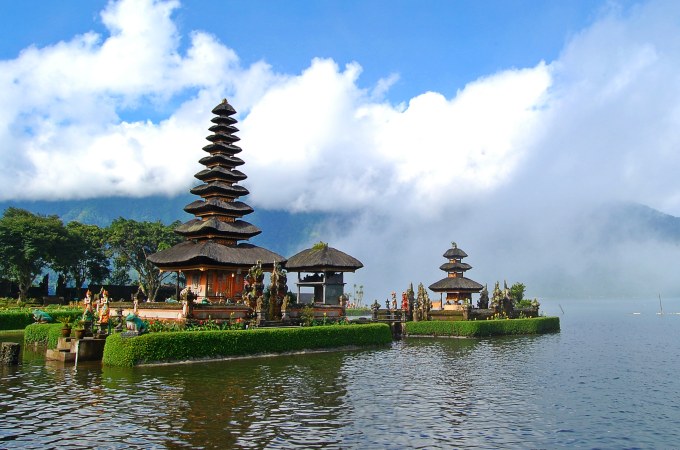
6
The road to Bedugul is bucolic, I’m sure everyone who has gone to the north will agree. Rice fields are strikingly green; they look very promising! And there’s no better way to enjoy the scenery than to sit back and relax inside a Perama shuttle. There were only five of us today including the driver. Behind me were a lovely Australian couple and a middle-aged Englishwoman engaging in a conversation. The rain started to pour in the middle of our journey and my reflective moment got magnified by thoughts of my childhood summer vacation (again). I was brought back to memories of coconuts, rice fields and beaches. The thing about traveling is that I get to conglomerate old experiences with new ones—different experiences do manage to find something in common. But my being in the moment didn’t last long as it got interrupted when the middle-aged lady behind me started rambling. It was so difficult to ignore, this unique case of verbal diarrhea. Also, I couldn’t find my earphones! That felt like it was the longest one hour of my life
By the time I arrived in CLV Hotel and Villa in Bedugul, the sun was out again and was greeted by crisp cool mountain air brushing against my face. Sri of the front desk welcomed me. She then handed me the key and took me to my 2-bedroom villa.
“If you need to go to the temple, we have a complimentary shuttle service and the driver will be more than happy to take you there. Just give us a call.”
These were Sri’s last words before going back to her desk.
I feel so happy I am getting more than what I paid for at this hotel. I mean, for only USD 30.00 not only am I staying at a villa with a modern kitchen and comfortable living room, but I have a driver and car placed at my disposal. I am beginning to love it here.
There is not much to do today other than go to the temple which is just half a mile away. I unpack before giving the front desk a call.
“What’s your name?” I ask the driver.
“Ketut. Sorry, I speak only little English.”
I didn’t ask any further.
Yesterday I was with Ketut (Arnata) on the back of his bike and now I’m getting acquainted with another Ketut in the car on our way to the temple. This naming convention is so unique you can instantly guess one is Balinese by their first name. Here, the Balinese Hindus are named according to the order of birth. The first born is named Wayan, the second Made or Kadek, the third Nyoman and the fourth Ketut. So what about the fifth-born? Yes—you guessed it right. The fifth is Wayan (Balik). Interestingly, Wayan, Made, Nyoman and Ketut mean first, second, third and fourth. I can imagine how many Wayans and Ketuts there are on this island. If I was Balinese, I would be a Made. Why was I not born a Balinese?
It took only a few minutes for us to arrive at the Pura Ulun Danu Beratan. Ketut hands me a card telling me to give the hotel a call when I need to be picked up. I wave goodbye and enter the temple premises.
This temple complex is massive and I am greeted by an abundance of tropical flowers as I walk hurriedly to get to the main temple. Pura Ulun Danu Beratan is perhaps the most iconic temple of Bali. (I am not kidding. Just look at the 50.000 Rupiah banknote and you will see get my drift.) It sits on the shores of Lake Bratan, erected in the 17th century to honor the lake goddess Dewi Danu. Add some fog in the scenery; the temple becomes a photographer’s delight—a captivating marvel.
And my shutter is now complaining of abuse.
A few months ago I had an Indonesian friend teach me a few phrases and sentences. Since today is my birthday and I am standing in front of one of my dream destinations, I offer a prayer of thanks in their national language.
I say: “Terima kasih tuhan untuk semua berkat. Indonesia adalah sebuah tempat yang sangat indah!”
And I abuse my camera shutter once more.
7
I never thought I’d discover Rumah Makan Anda, a nice local warung along Jalan Raya Bedugul. I decided a meal before going back to the hotel would be perfect. I tried to ask the guy in charge to help me make a phone call, but was unsuccessful as he couldn’t communicate well in English. I tried to look for the card Ketut handed me earlier in hopes that he would understand what I was trying to tell him. I was beginning to fear I misplaced it, but luckily found it tucked in one of my pockets. I handed him the card and his face suddenly brightened upon realizing I have wanted to make a phone call (all along!). While waiting for Ketut I decided to order a Gurami Bakar (Roasted Gourami) and a Bintang. It didn’t take long for my order to arrive, and upon tasting it, I was instantly blown away; it was awesome.
Ketut arrived shortly and asked how my day was. It’s nice that he’s finally making conversation. When I told him it was perfect, I tilted my head to look outside and witnessed the sky in its most cinematic. It is now late afternoon and I am back at the hotel.
I managed to buy a few bottles of Bintang a few minutes earlier, thanks to Ketut’s driving me to a non-Muslim store after he picked me up. It’s funny that before I even made a phone call for Ketut to pick me up, I found myself in a wrong Warung—inappropriately and unwarily asking for bottles of Bintang—only to realize it’s labeled “Warung Muslim” (Bedugul’s Muslim community is huge). Had I realized my faux pax sooner, I wouldn’t have attempted it, but the lady just ignored me the same way you would ignore an insane person, unaware of the consequences. And I couldn’t blame her.
This afternoon I have nothing else to do now but to unwind and end the day with yet another quiet, solo celebration at my villa. It’s getting cold outside and it suddenly occurred to me that maybe staying on the front porch—as I let the chilly air penetrate my skin while having a Bintang—is how I should be ending it.
What an interesting day.
Part 3
Southern Bali:
Kuta and the Bukit Peninsula
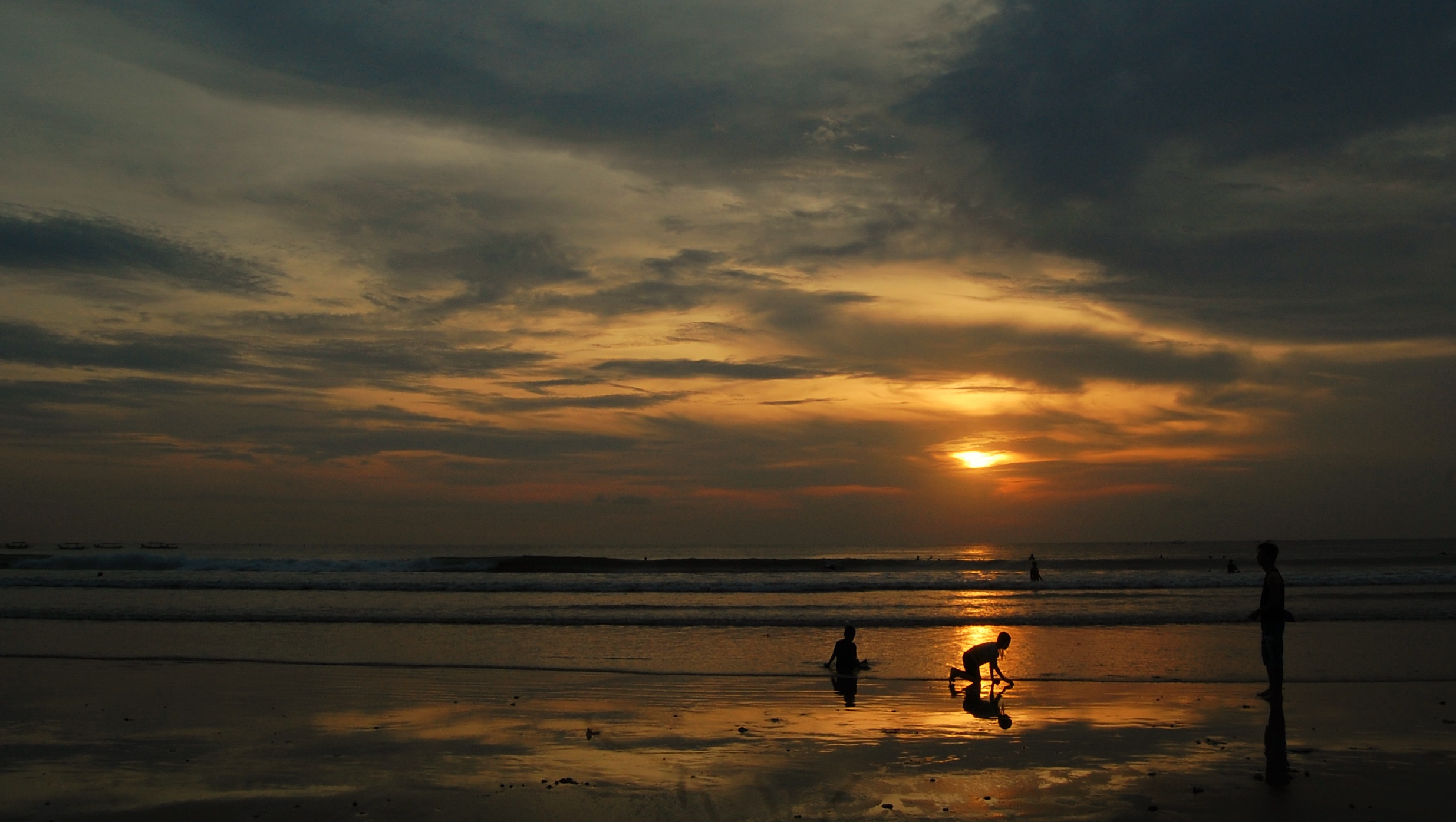
8
It’s a sunny afternoon in the Bukit Peninsula on the southernmost part of the island. My expectations earlier were high enough to keep me awake in spite of the lack of sleep because I had to wake up really early today to travel from the north. It hadn’t occurred to me, however, that I would be up for a hair-raising experience. The expectation was—as discussed with Hamim last night—he would take me along with him in the south. I met him yesterday in Bedugul. (When he introduced himself, I got little confused as to why he is not a Wayan, Made, Nyoman or Ketut. Turns out, he is Muslim. This is Indonesia after all. (It’s nice the Balinese Hindus and Muslims co-exist harmoniously) And so here I am on the back of him motorbike, praying silently we don’t get into an accident. He drives with much confidence, shrugging the idea that we were going to get into trouble, as he speeds his way through the uneven paths leading to Dreamland beach, it is almost like a rollercoaster ride, only I wasn’t strapped or something, but clutching. Hard.
“This is where locals pass, you know?” He tells me with much pride. I nod three times in agreement. This alternative path has a view that is so scenic; the tourists are missing a lot.
(For some reason, the music of The Beach Boys keeps laying in my head. It plays over and over I feel like I have accidentally pressed my mental repeat button. It is such a guilty pleasure.)
We arrive on what seemed to be a not-so touristy side of Dreamland. This idea, this whole I-get-to-go-local thing, makes me giggle, I am glad Hamim is not noticing it. He parks and secures his bike and tells me to go to the top of the hill while he looks for a Bintang. So I follow his orders and go up to setup my tripod. Unfortunately, it is not cooperating. Today. Where everything in front of me is beautiful. Not my day today, I say to myself. Hamim comes back with two bottles of Bintang and tells me the people I see below are mostly Indonesian. Today is a national holiday, he continues. Whatever happened to the Australian holidaymakers?
You know what? I have always wanted to come here, this beach called Dreamland. Sadly, like many areas on Bali, this too is bound for rapid development. Soon the Bukit Peninsula, now known as New South Kuta, will be entirely surrounded by 5-star accommodations it is almost sad to imagine what lies ahead in the future. And it has already begun. I feel lucky that—at least in one area of Dreamland—there is still a local vibe.
And that vibe will soon vanish.
Our stay is cut short when we realize it will soon rain. The sky now looks turbulent, I guess it needs a drink. So we leave and head to Pura Luhur Uluwatu, a temple perched on a cliff and famous for its sunsets. Legend has it that lovers who view the sunset together will be cursed. I don’t know where that story came from, but I’ve heard of people professing it to be true. I am guessing three friends together might be an exception; also the sun is now obscured by a thick layer of clouds, I am confident all curses will be lifted.
Hamim tells me, in a polite manner of course, to shut my mouth while he negotiates for the price (locals apparently have a different rate). He then wraps a purple cloth that is supposed to function as a sarong, he says he looks ridiculous. We all laugh. And it’s a good thing I am wearing the sarong I got from Made a few days ago.
Uluwatu is notorious for its monkeys. Visitors are warned of keeping an eye on their belongings, particularly sunglasses as there have been reports of theft caused by these little creatures. I had my firsthand experience with the monkeys earlier when I almost got attacked—as I took photographs of them—by them as they sat on a cliff busily eating. I am just glad I didn’t have any sunglasses with me. Earlier I heard someone screaming on top of her lungs. I found out the nasty monkey took the poor lady’s sunglasses away.
And speaking of monkeys, just as we were about to leave, I overheard this conversation between a tour guide and a foreign tourist:
“Where do these monkeys come from?” The tourist asked.
“They came from India centuries ago.” The responded with conviction.
“How did you know?”
What a sarcastic remark.
9
Earlier I requested Hamim to take me to a local food stall, and so here we are back in Kuta in this unexpectedly non-touristy place where the food looks great and the abundance of sambal guarantees a trip to the toilet, only I didn’t go to the toilet because I love spicy food so much that even my newfound friend couldn’t stand the idea.
“You will eat all of that?” Hamim inquires, obviously appalled.
“Of course, I will!” I respond with confidence. “See—I am more Indonesian than you are, Hamim!”
I couldn’t resist a spicy meal. I am thrilled to see my already spicy Ayam Goreng swimming in a pool of sambal. Even the guy who served my food looked shocked. I am now drowning in an ocean of pure happiness. I am in heaven.
Hamim gives me a look of foolishness. Have I committed a culinary crime? I ask myself. You see, for an intrepid traveler such as myself, the exploration and utter enjoyment of the marriage of different (and oftentimes bizarre) flavors require commitment, no matter how spicy your plate is.
Which brings me to this question: When did I ever learn to love chili peppers? A few years ago, I couldn’t imagine myself being in a state of indescribable satisfaction at the taste, let alone the sight of a million chili peppers. But now, I couldn’t survive without it!
People do change, and so do their taste buds.
I return to my hotel and have a chat with my newfound friends, Rido and Rio from Jakarta. I met them earlier today while I was checking in. Rido is currently going to University while his brother Rio owns a restaurant in Jakarta.
“Please tell me when you coming to Jakarta. Eat…at my restaurant.” Rido tells me.
The idea is tempting. I mean, I haven’t been to Jakarta yet, and the thought of being invited makes me want to go book a flight to the capital, like—right now.
“Do I get a discount?” I ask sheepishly.
Rio looks at me as though he didn’t hear me, and in a sincerely curious fashion, together with his brother, asks, “When you coming to Jakarta?”
It’s also good to be friends with Indonesians from Java. I think I need another drink or two.
10
I wake up realizing I have overslept. Well, I shouldn’t be surprised. I was up the whole night with Trevor, an Australian who speaks impeccable Indonesian. I have made friends with him last night out of desperation. (We are staying at the same hotel and I was in need of a social being) I thought, a drink wouldn’t hurt. Also, I was bored.
Hours passed and we met new friends from Java—now residents of Bali—who wanted to join us for conversation. Seeing Trevor socialize in Indonesian at that moment made me look at him like he was this huge, good-looking middle-aged Australian magnet, who—given his knack for speaking the local language—couldn’t help but attract the Javanese men who joined us for a few drinks. And they did stay long. I think Trevor and I got home at around 5 in the morning.
So today is the day that should not be missed as I will be leaving Bali in less than 24 hours. Time is of the essence here, so I got to do what I have to do. I leave the hotel looking for a taxi to take me to a Ripcurl outlet store. I arrive a few minutes later eager to buy boardshorts (I am a surfer after all) for myself, and a cap and a shirt too! I manage to buy interesting inexpensive Ripcurl stuff (Surf gear is way cheaper in Bali) and now about to go back to the hotel when suddenly, my flipflop strap got broken. What an unfortunate situation!
What do I do now? Do I go back to the store to buy a new pair or should I just go barefoot temporarily until I arrive at the hotel (I’ve got an extra pair in my bag, anyway). I choose the latter.
Still it’s embarrassing. I am glad I manage to laugh it out and assured myself that I have made the right decision. Where are the taxis when you need ‘em—I ask myself. There must be a taxi somewhere. Never did I imagine standing on the sidewalk in the middle of Kuta, barefoot and desperate for a taxi and praying Hamim doesn’t wait too long at the hotel.
Out of nowhere a taxi comes to the rescue and the driver takes me back to my hotel. Hamim arrives a few minutes later and offers a Band-Aid solution to my broken strap. Somehow he manages to connect the rubber parts by using a lighter to melt them. Wow, this Hamim is like an angel! I am beginning to imagine him with wings—big bright ones!
Hamim takes me to the beach as I was hopeful to witness a spectacular sunset that I wasn’t able to experience at Uluwatu yesterday. (Curse or no curse)
We arrive at Kuta beach looking for some chairs to sit on for a Bintang session. It’s crowded here in Kuta as expected; therefore finding a spot is like winning the lottery. Luckily, we manage to find one spot where Bintang is readily available. We open our bottles and talk as the sun shines on our faces in perfection.
For some strange reason and without warning an old lady massages my back and, quite frankly, offers me a discount—”an afternoon price”. What happened to the signature “morning price?” I smile and politely declined.
I am starting to feel a little sad. Time is really fast—the sun is now setting and the sky begins to showcase a myriad of contrasting colors, it is impossible not to adore it. And it is teasing me to stay. But I can’t. I just can’t. I can’t help but take my camera and fire wonderful evening shots of the horizon now resembling a painting of an old master.
This is the moment period
I head back to our spot to reunite with Hamim and his friend, I notice an enthusiastic voice from a distance.
“Mom and dad, I’ve finally made it here. Wherever you are I know you are so proud of me,” says a middle-aged European lady while looking at the sunset, apparently thrilled and looking really accomplished. She then holds the old lady’s hands (the lady who offered me a massage discount earlier), kisses them as a sign of gratitude and departs with her oversized backpack. She’ll be back—I say to myself.
It’s hard to articulate how I feel seeing her depart, but one thing is certain: Like me, she is a Kartikeya…and she is off to somewhere.
I now look back at the countless trips I took in the past the same way I flipped through the pages of the atlas, then my favorite book, when I was three years old, and it makes me ask myself:
Having been to many places, has it defined me as a person? Have I really changed?
A friend once told me I have been beautifully-crafted and intricately-designed for cross-cultural understanding. So I wonder: What’s next for me? What really is my purpose? Where do I go next? Is this sheer naivety and foolishness? When do I get to go to the Gobi Desert in Mongolia? Do I get to start my own charitable foundation? How do I prevent wrinkles from appearing?
I’m sorry—am I still making sense?
You know what’s strange? I’ve never really answered the number question people I have met here have had for me.
They have asked: “When are you coming back?”
Soon. Very soon.
—Vince, February-March 2016

















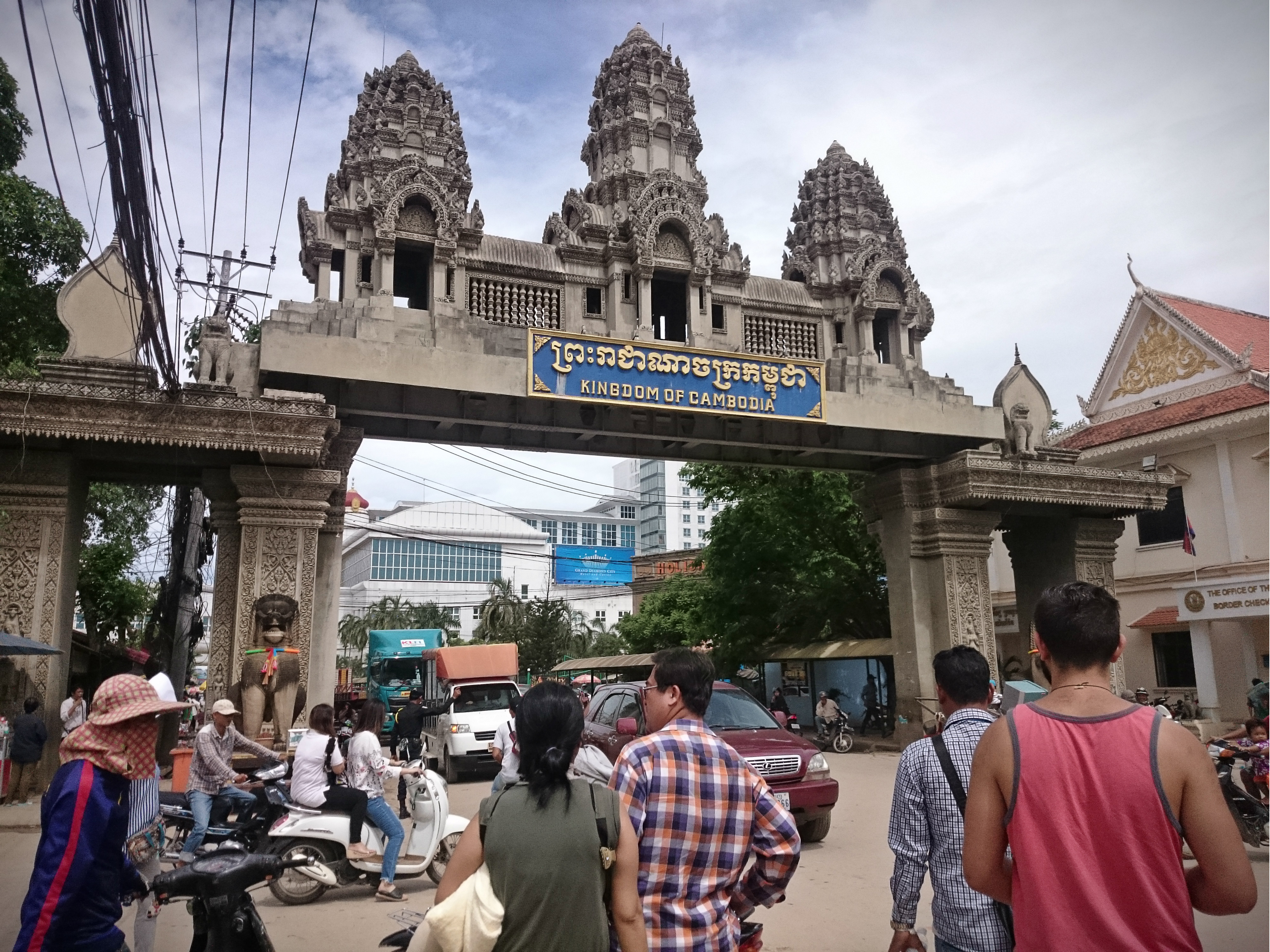

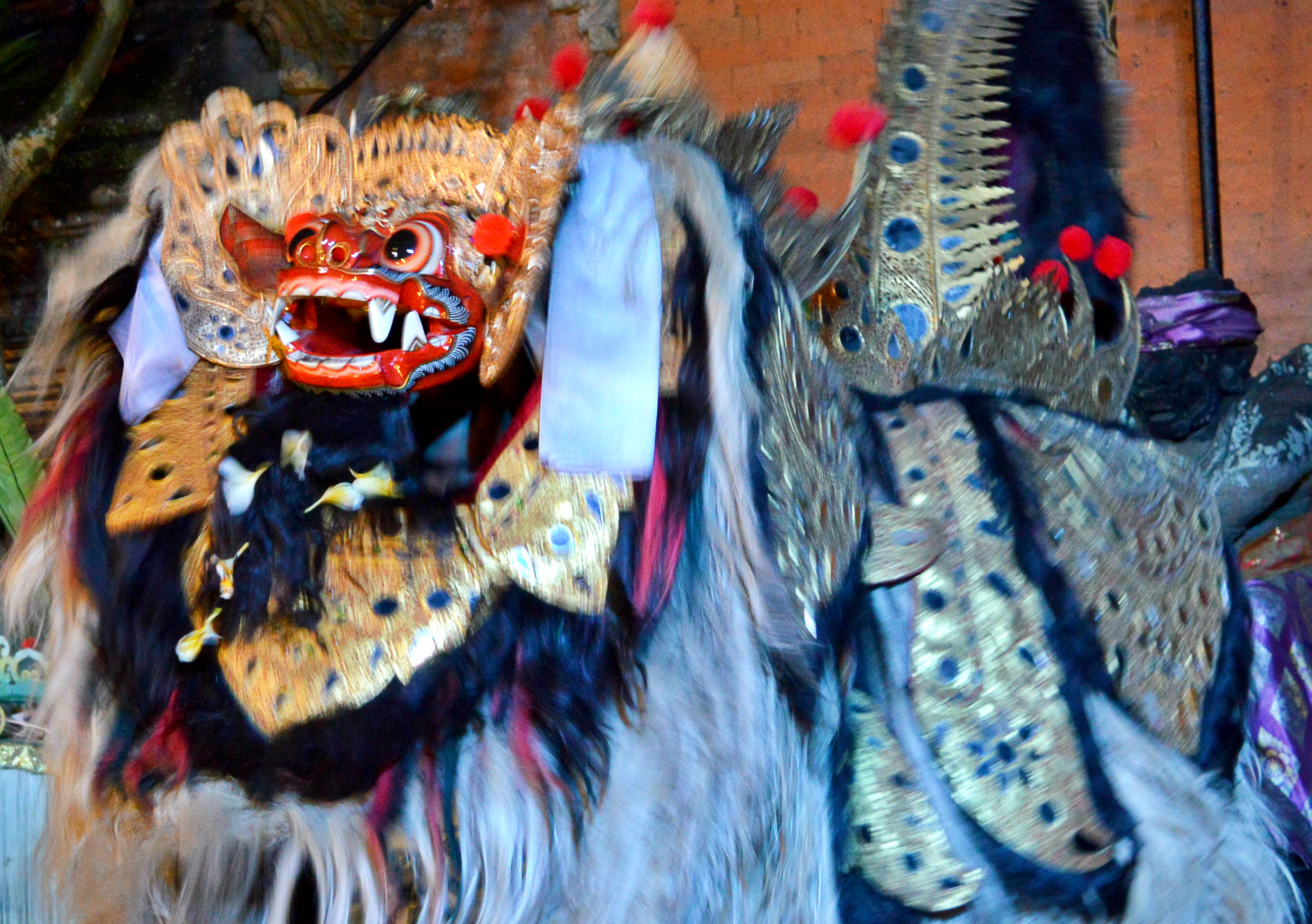
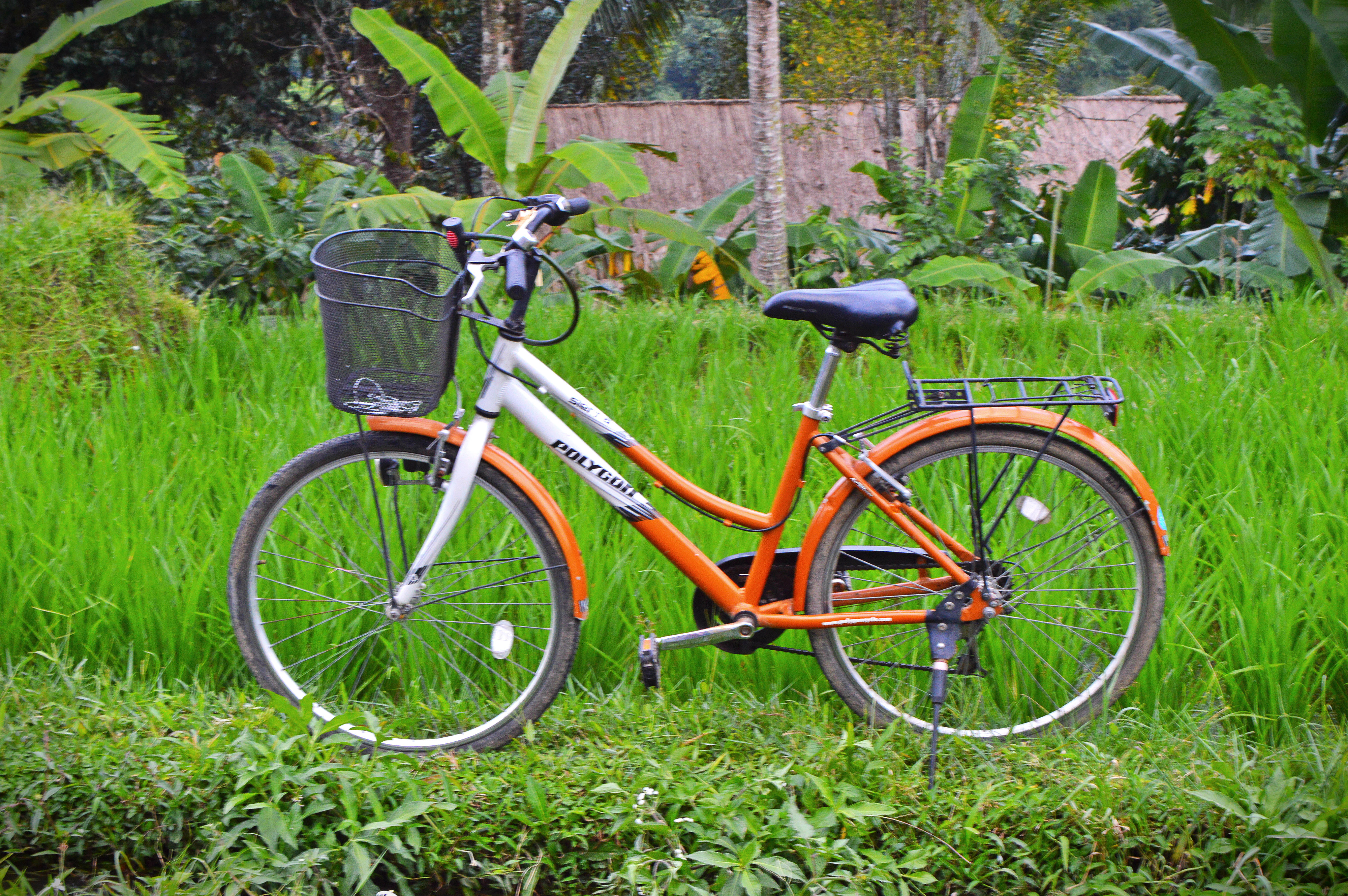
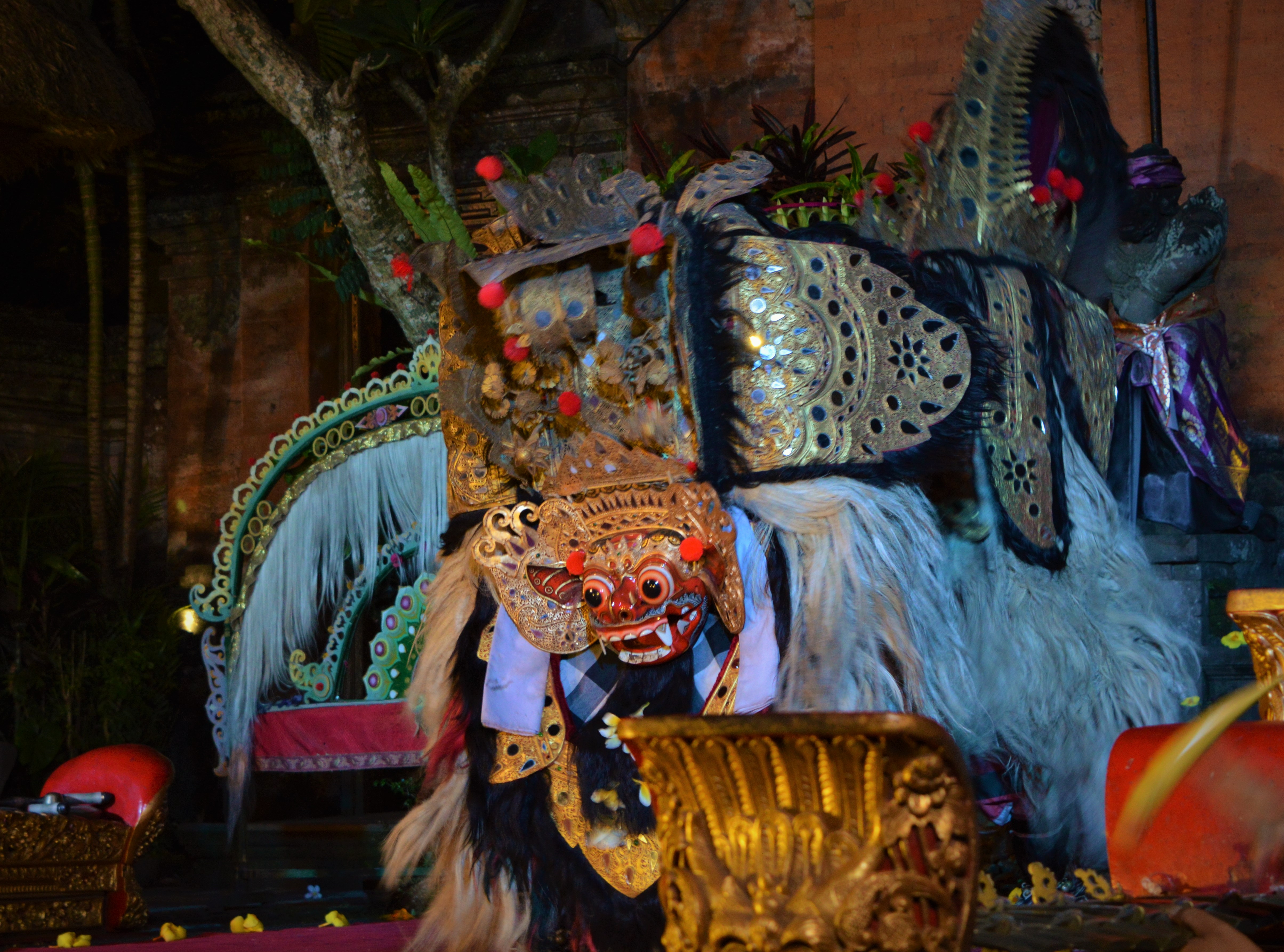
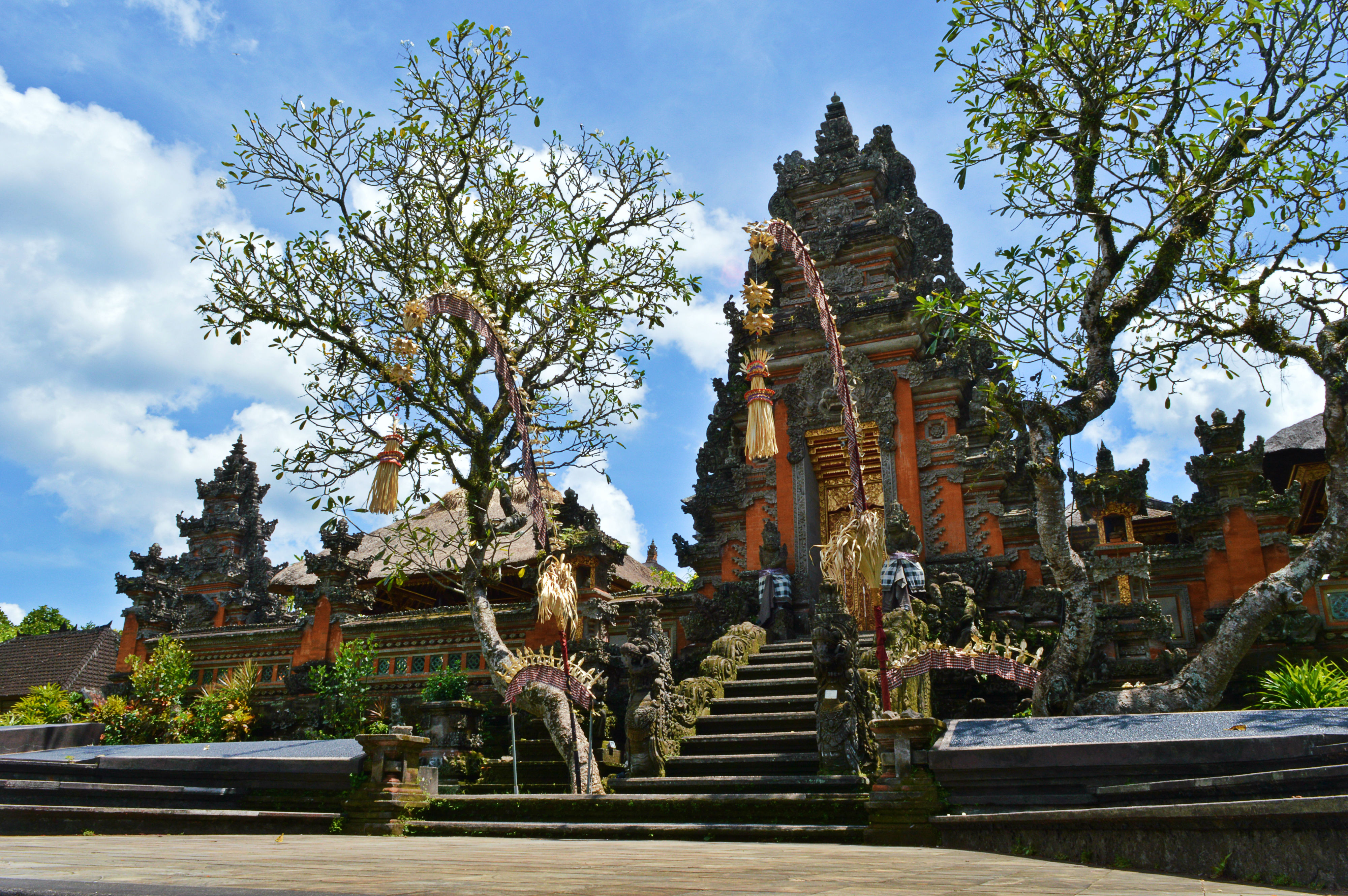
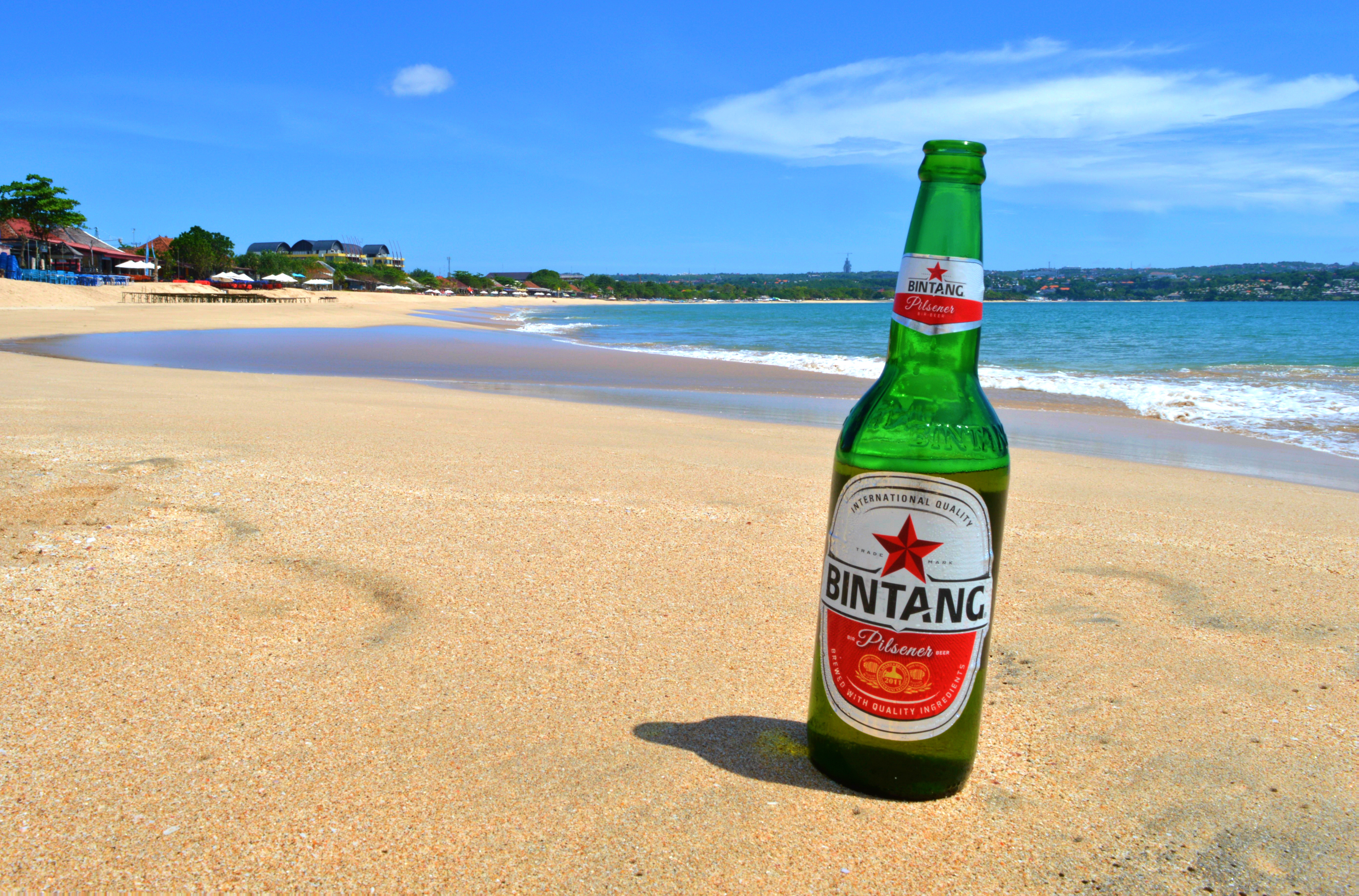
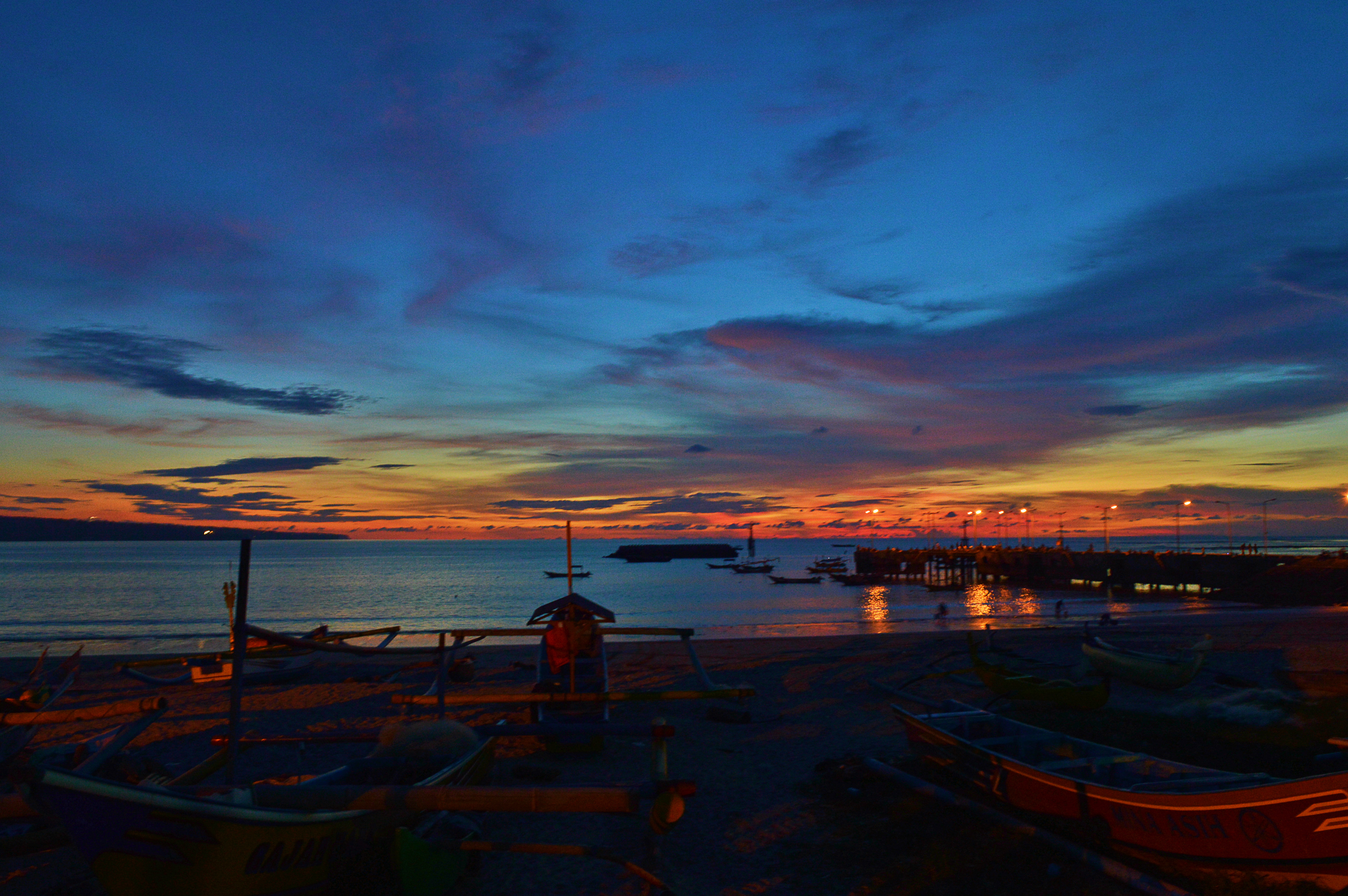 That afternoon, as I was sitting on the shore with my Bintang while watching the sunset, a middle-aged man came to me and initiated a conversation.
That afternoon, as I was sitting on the shore with my Bintang while watching the sunset, a middle-aged man came to me and initiated a conversation.
